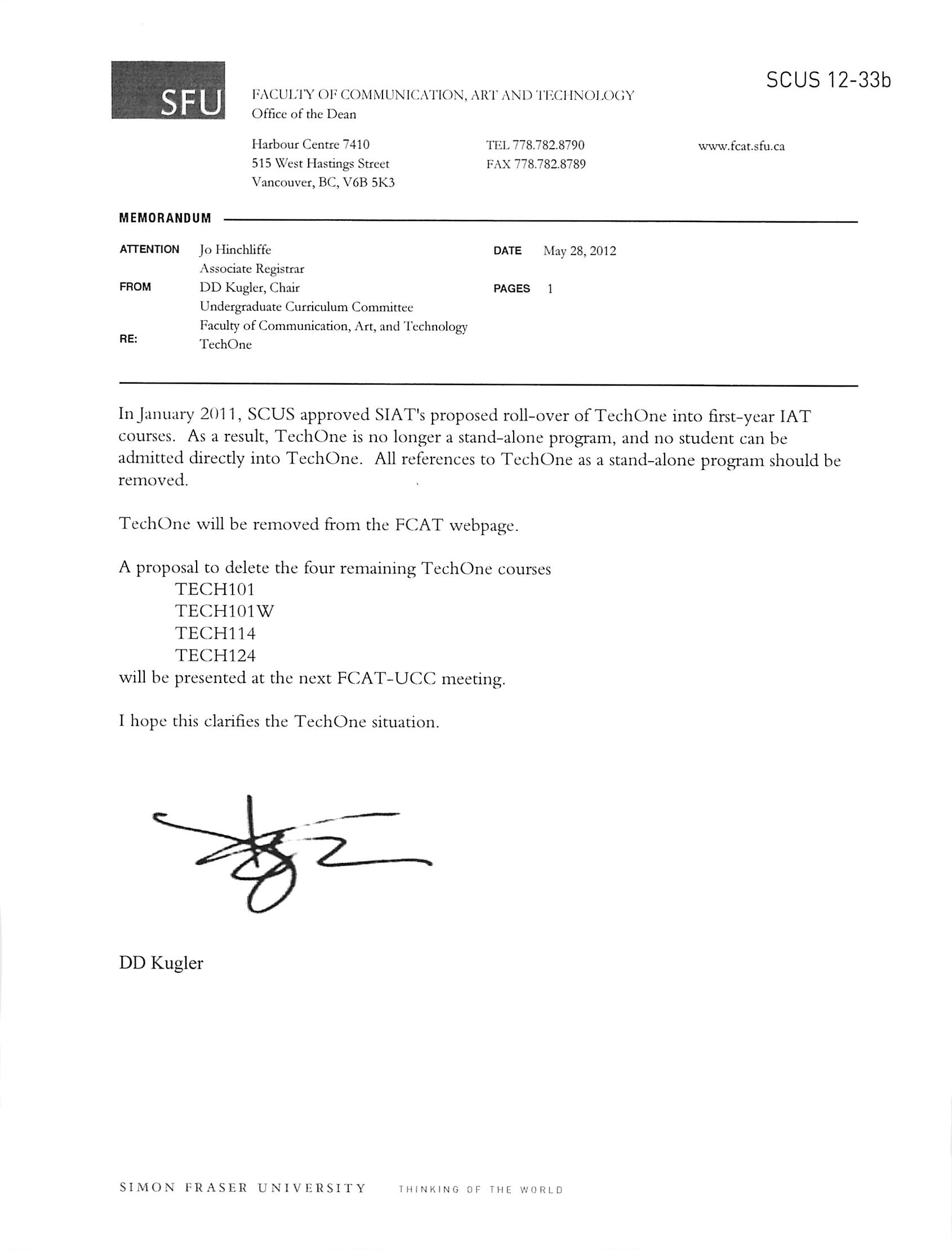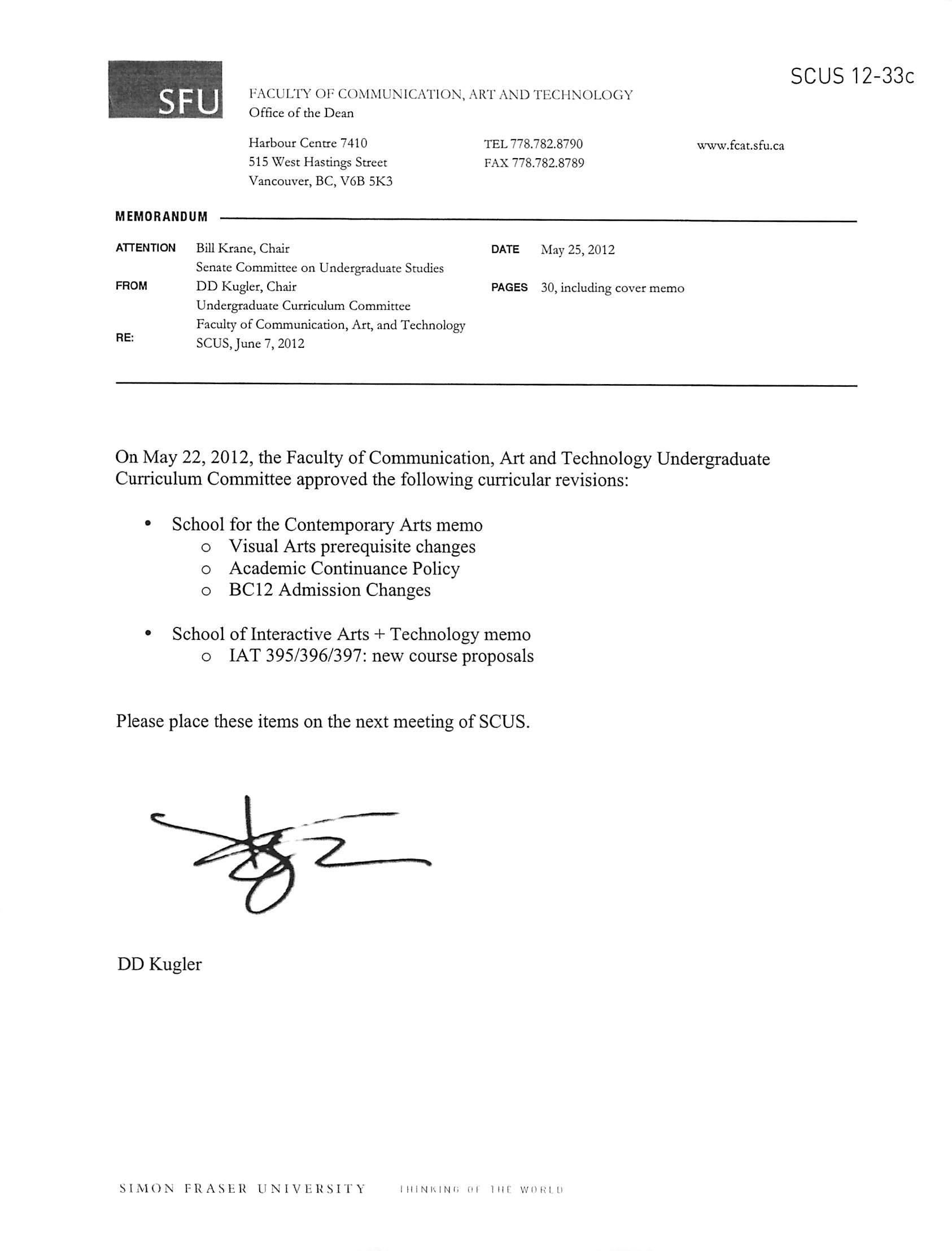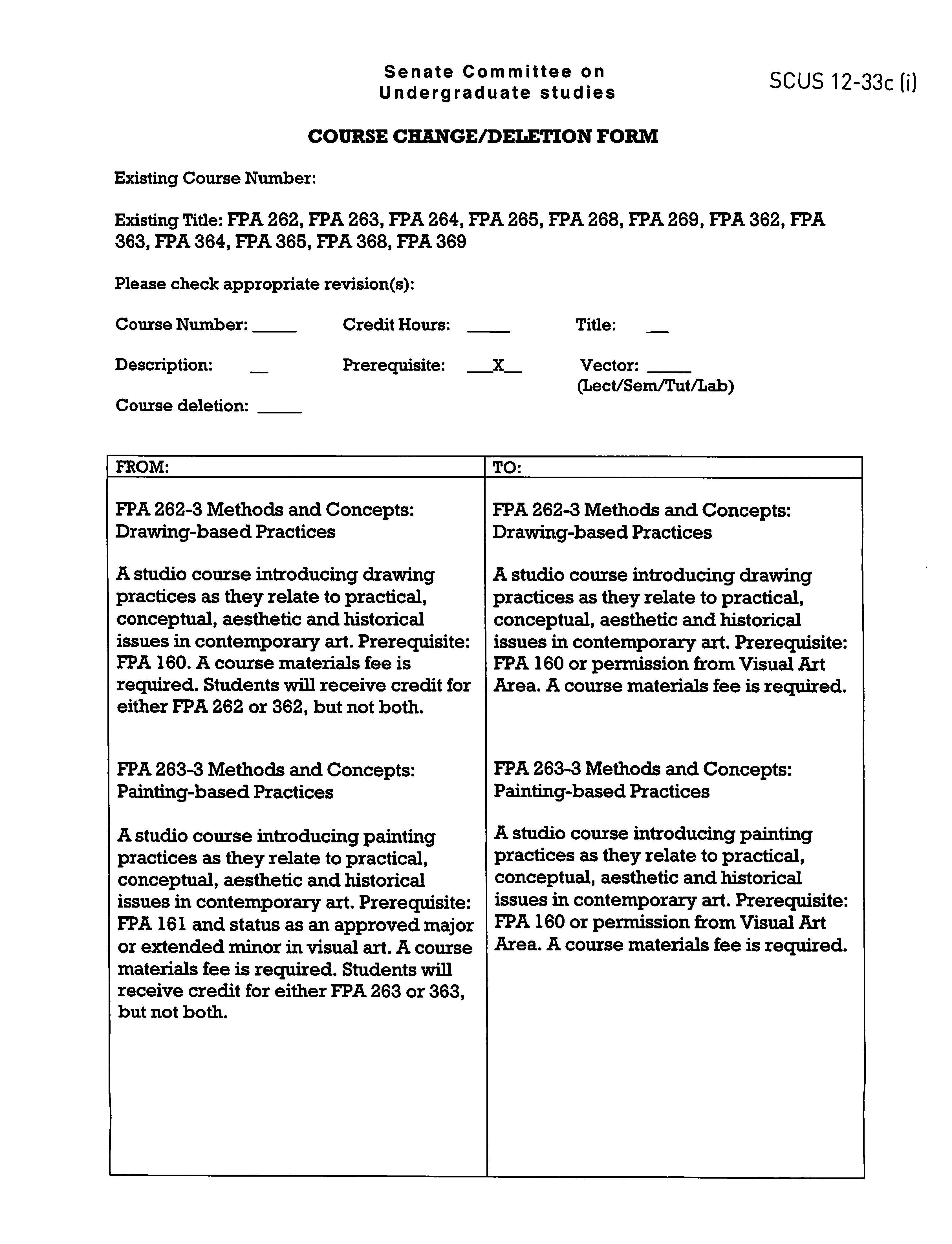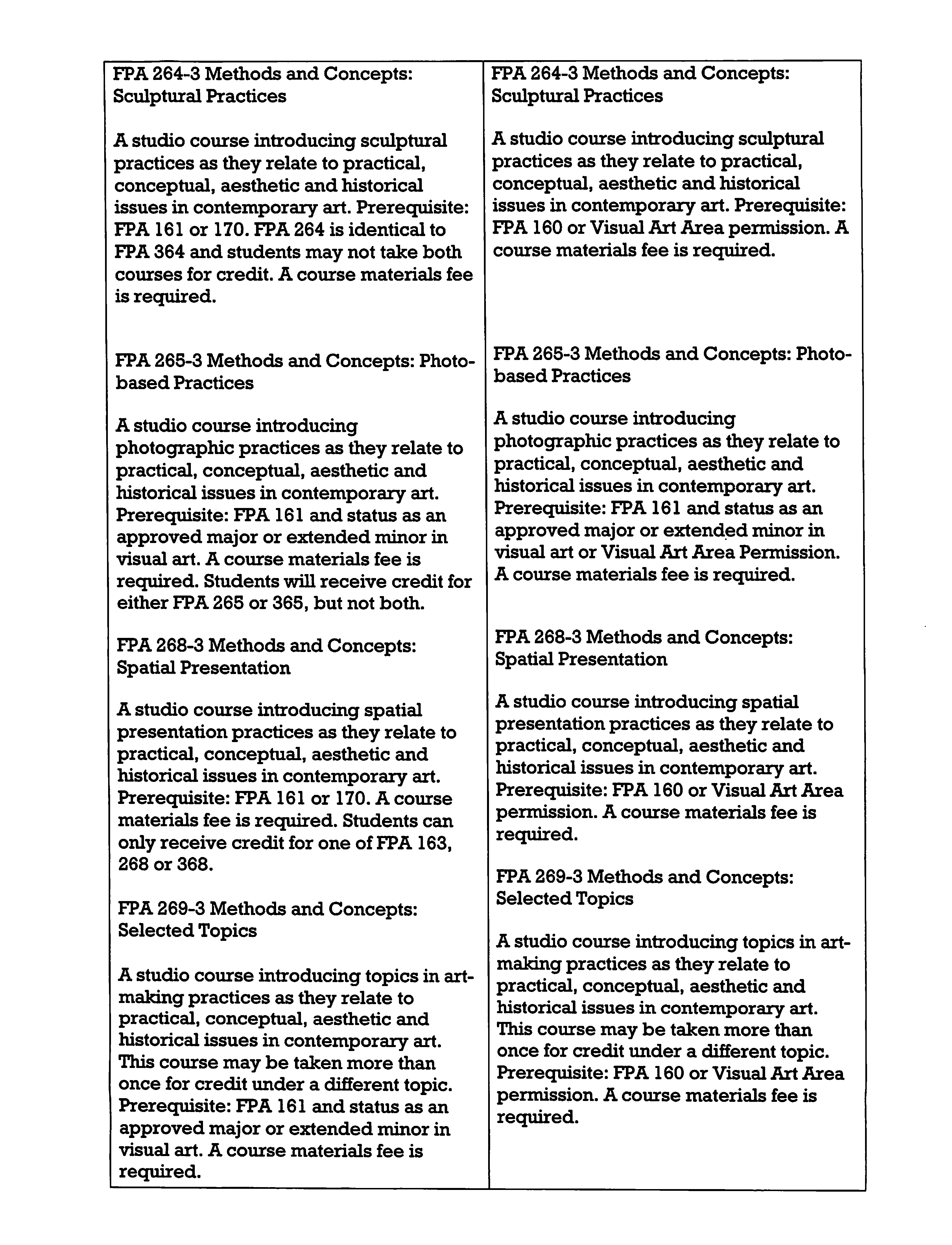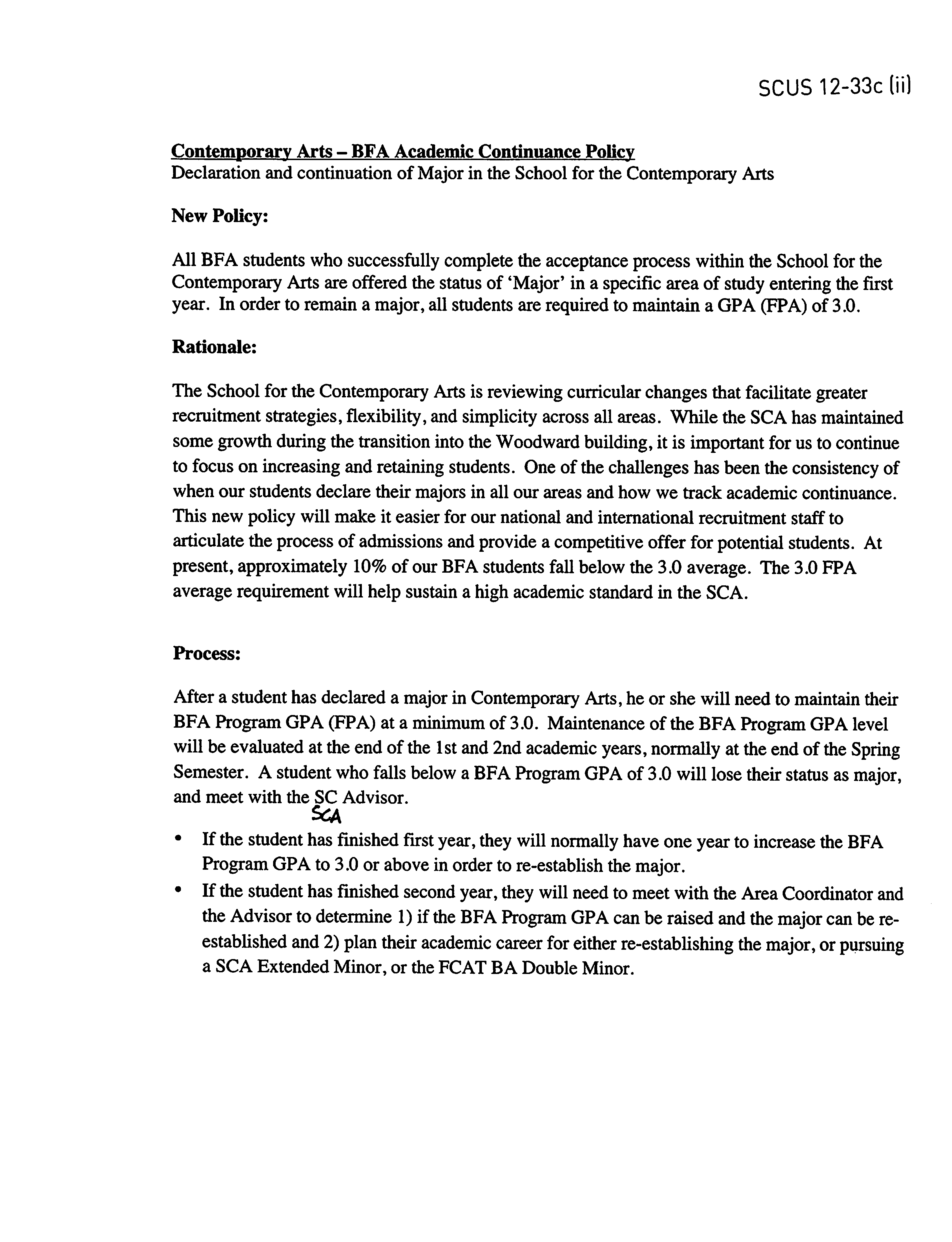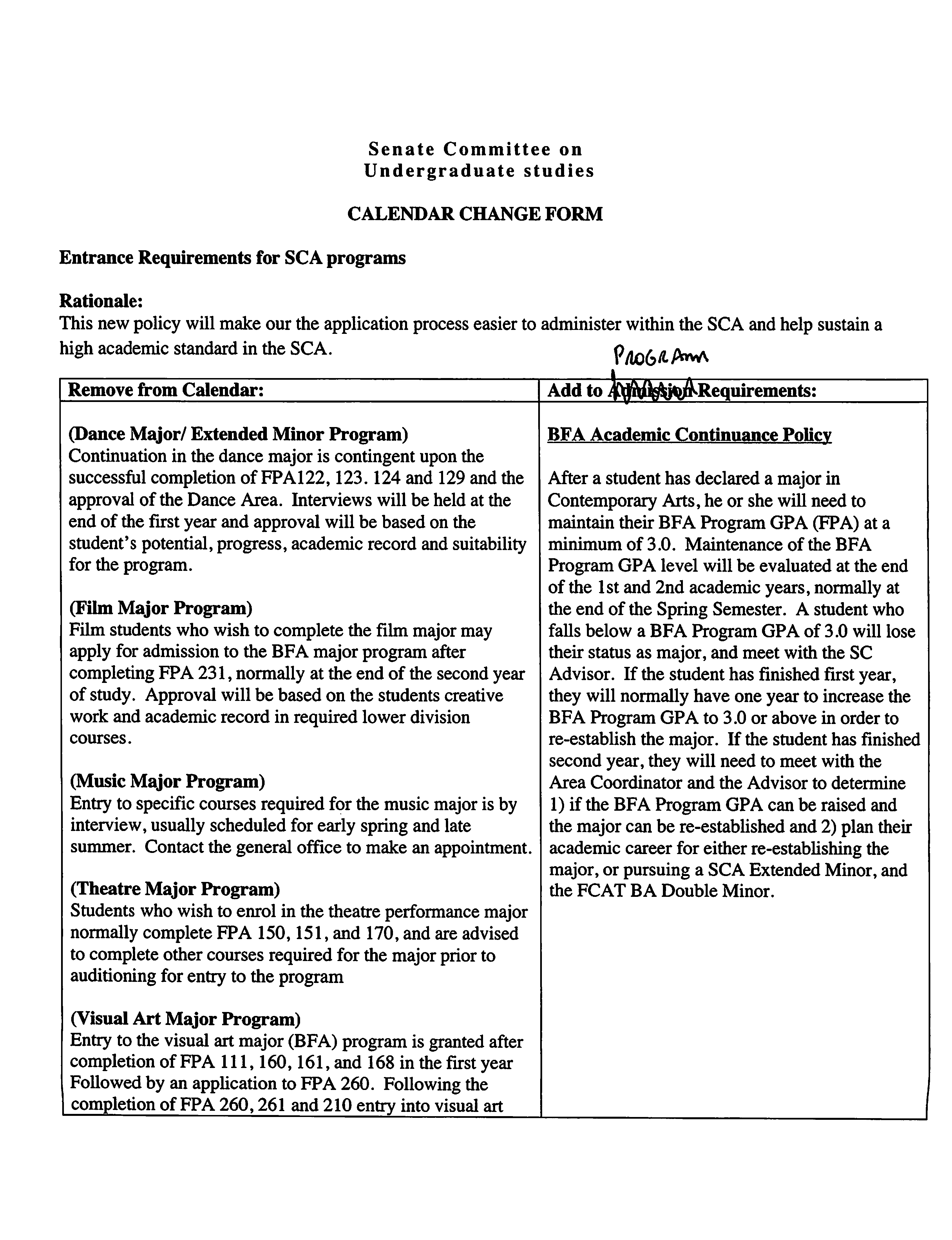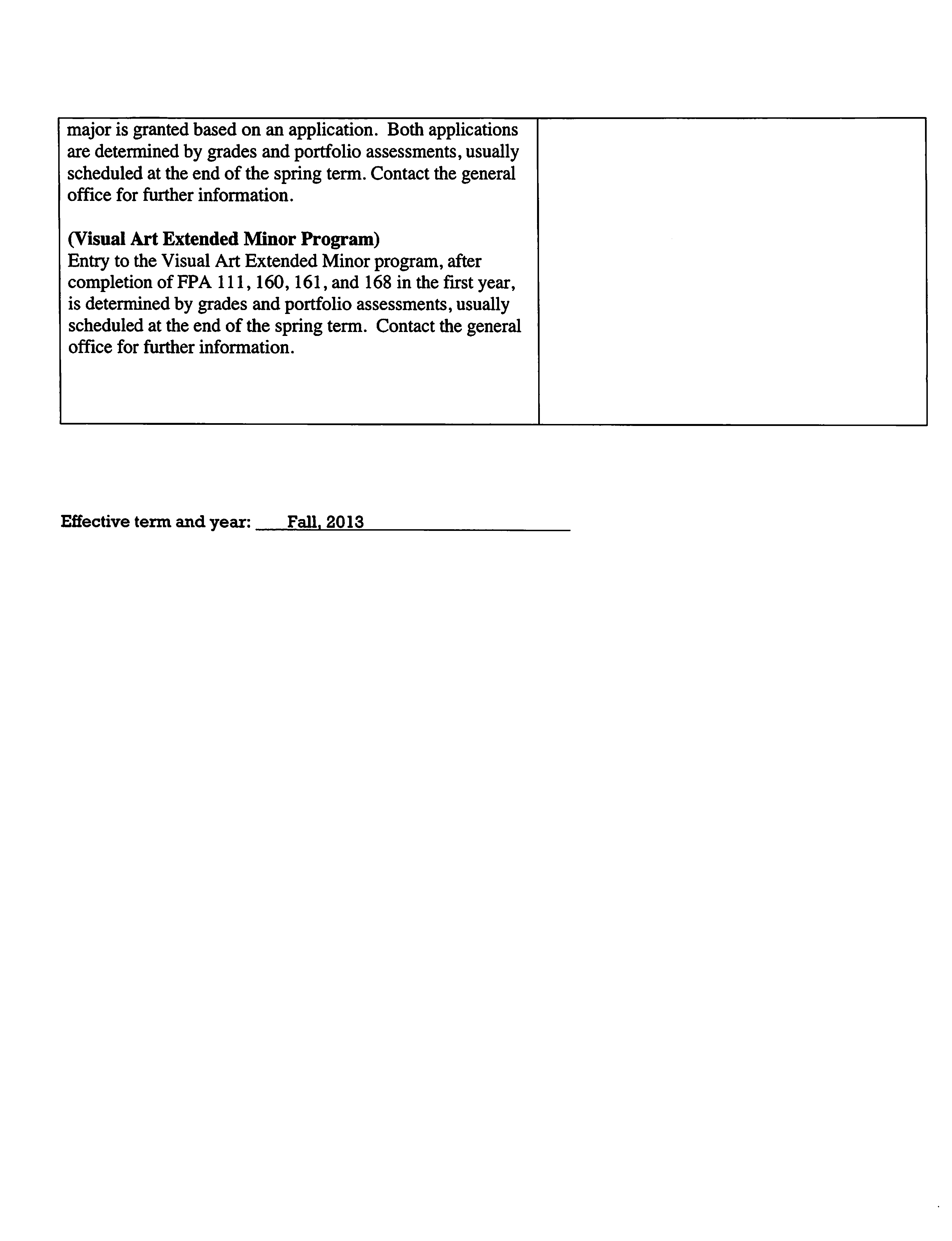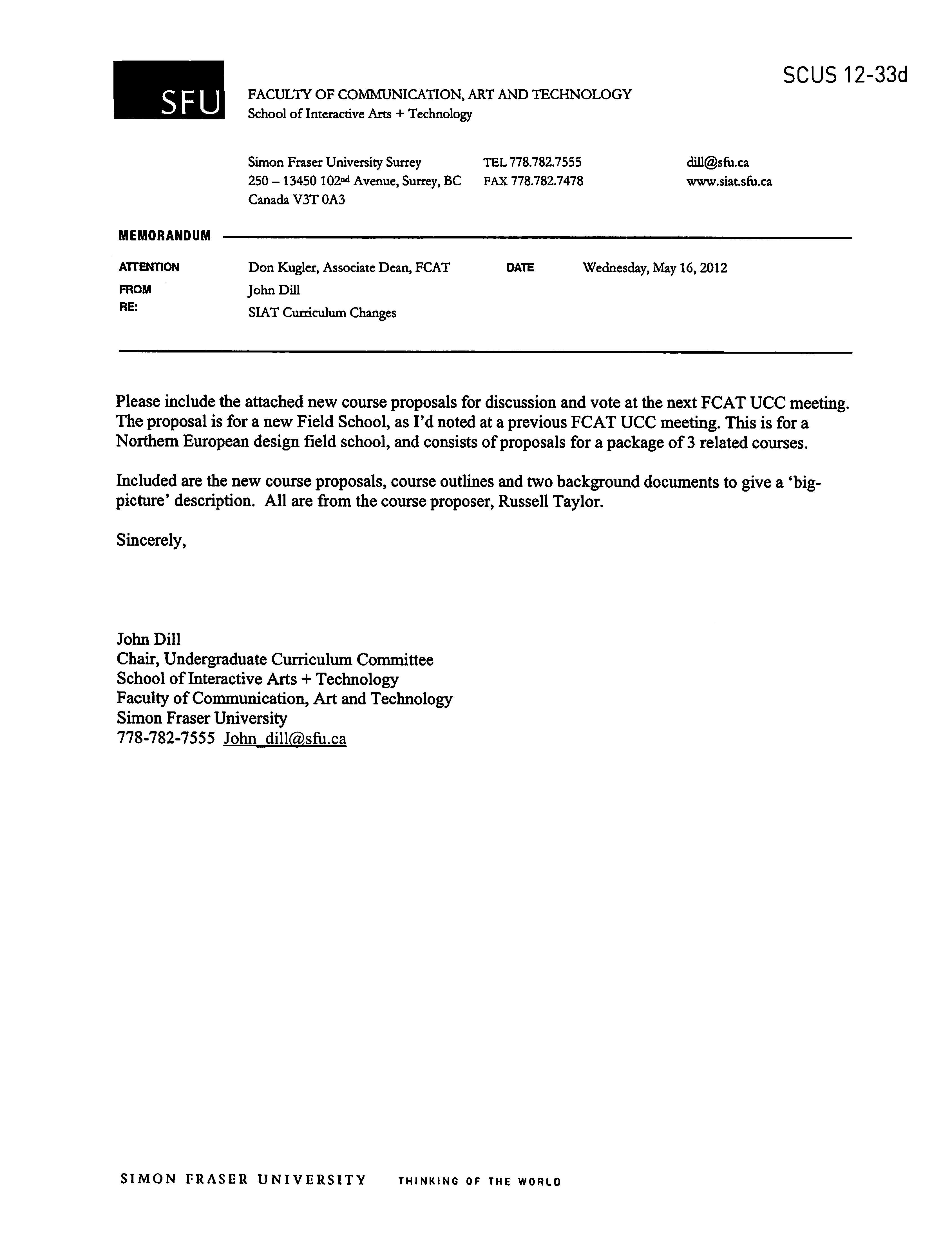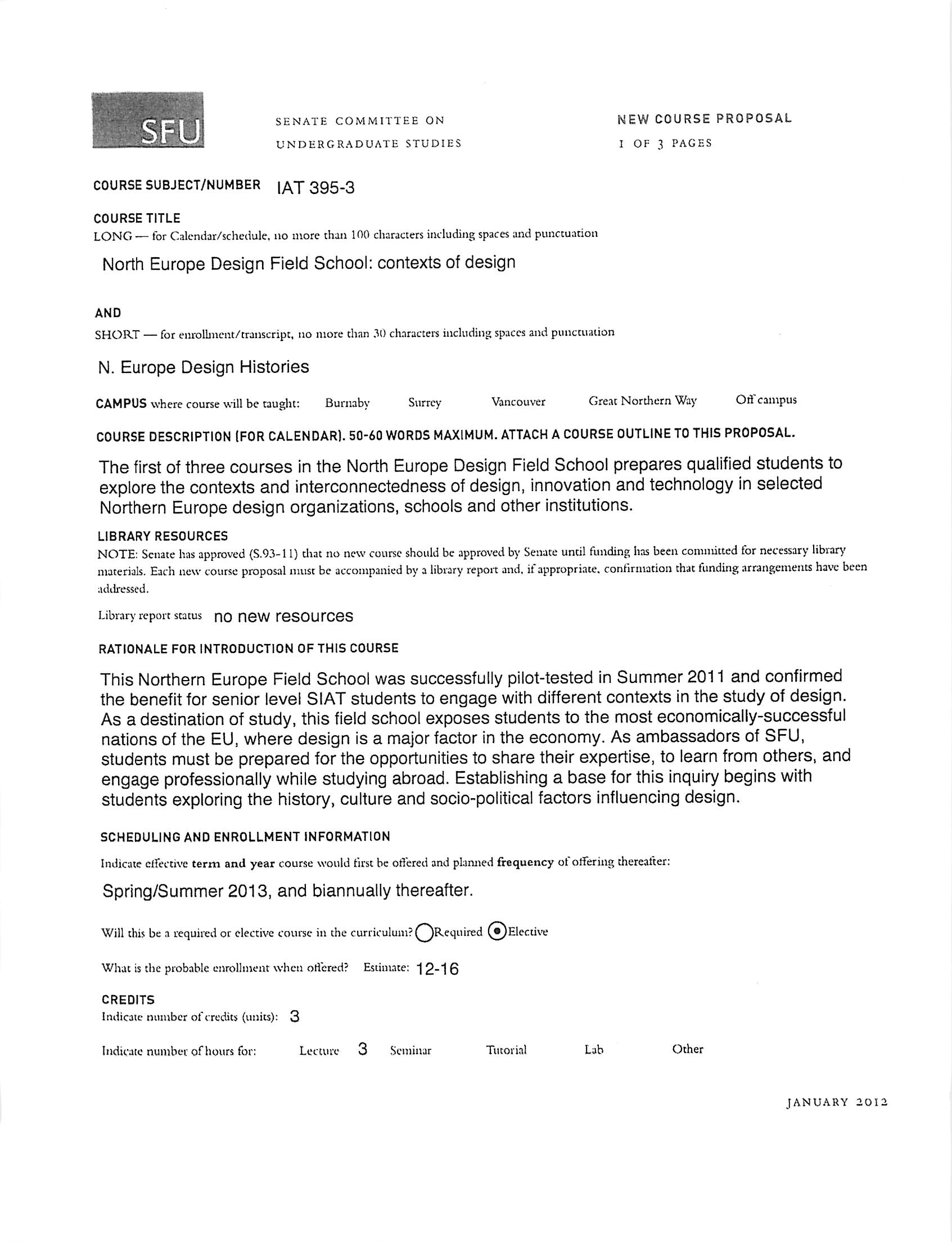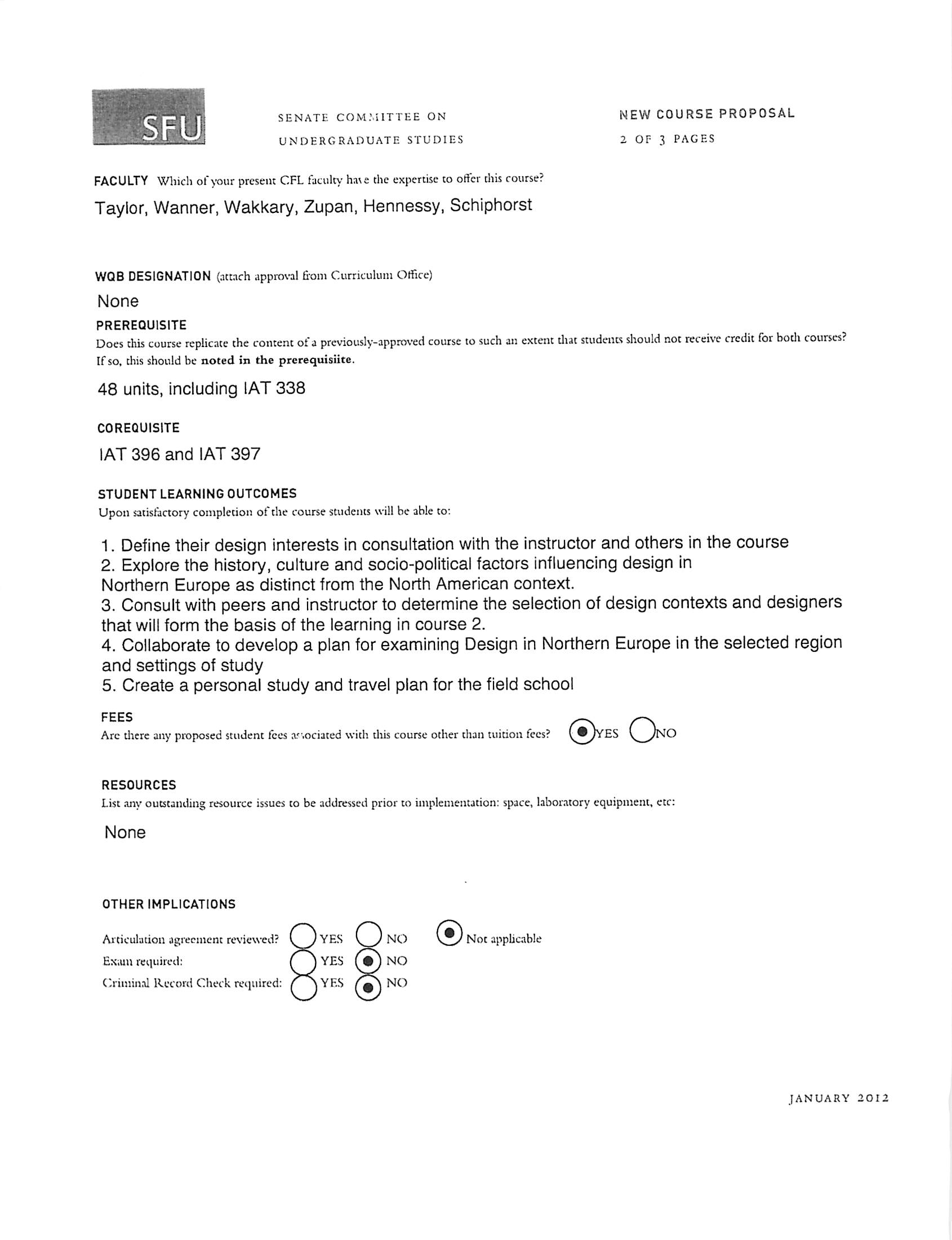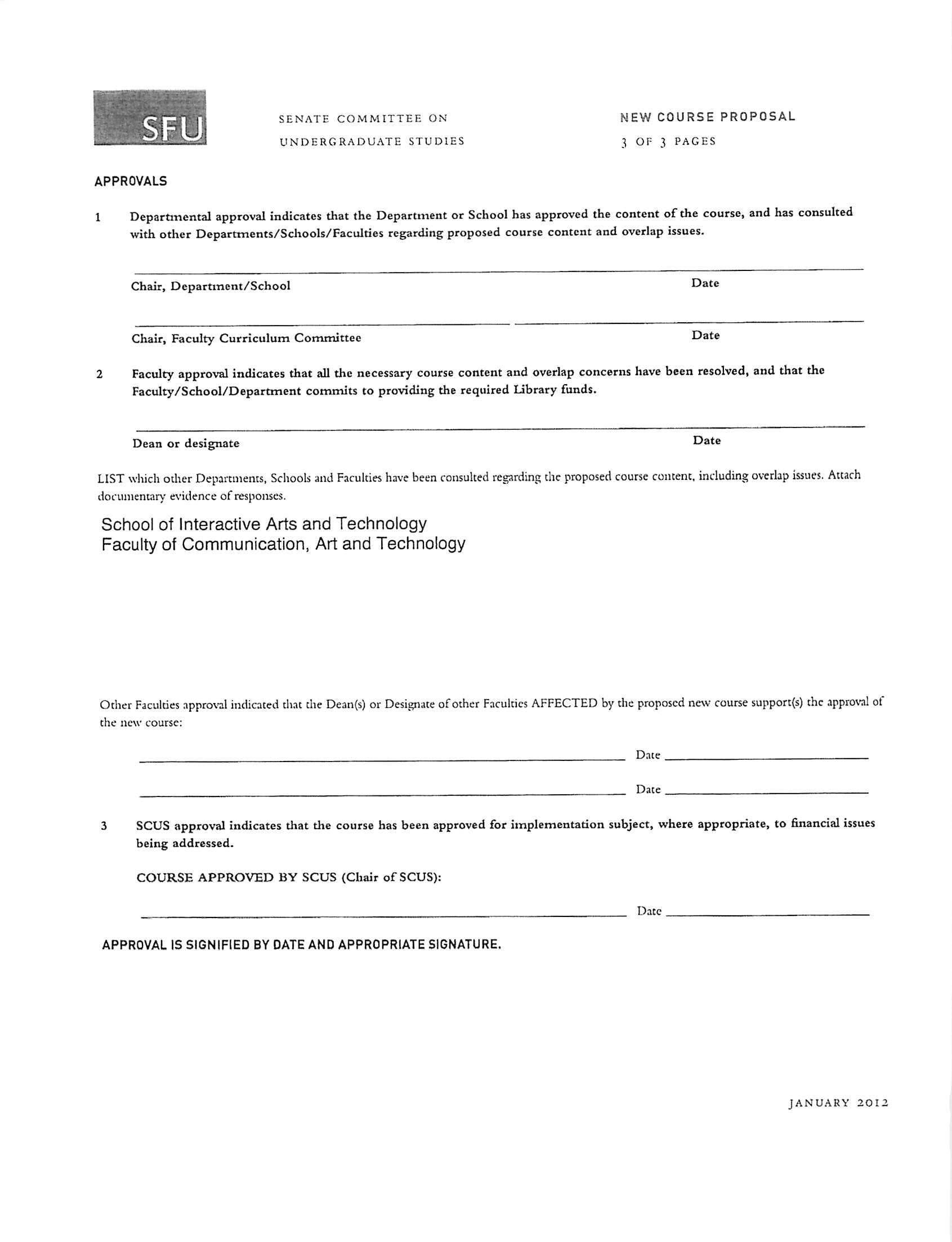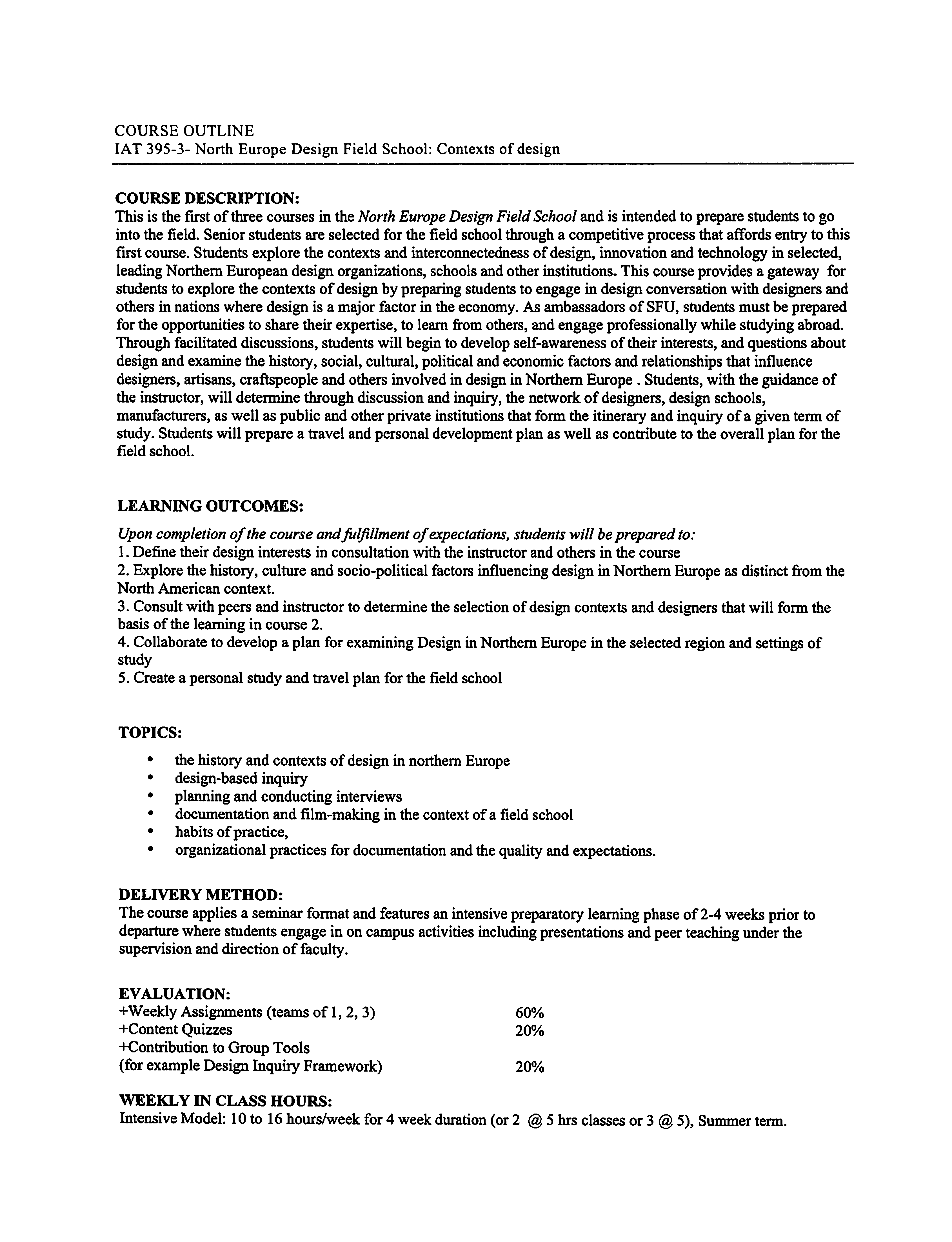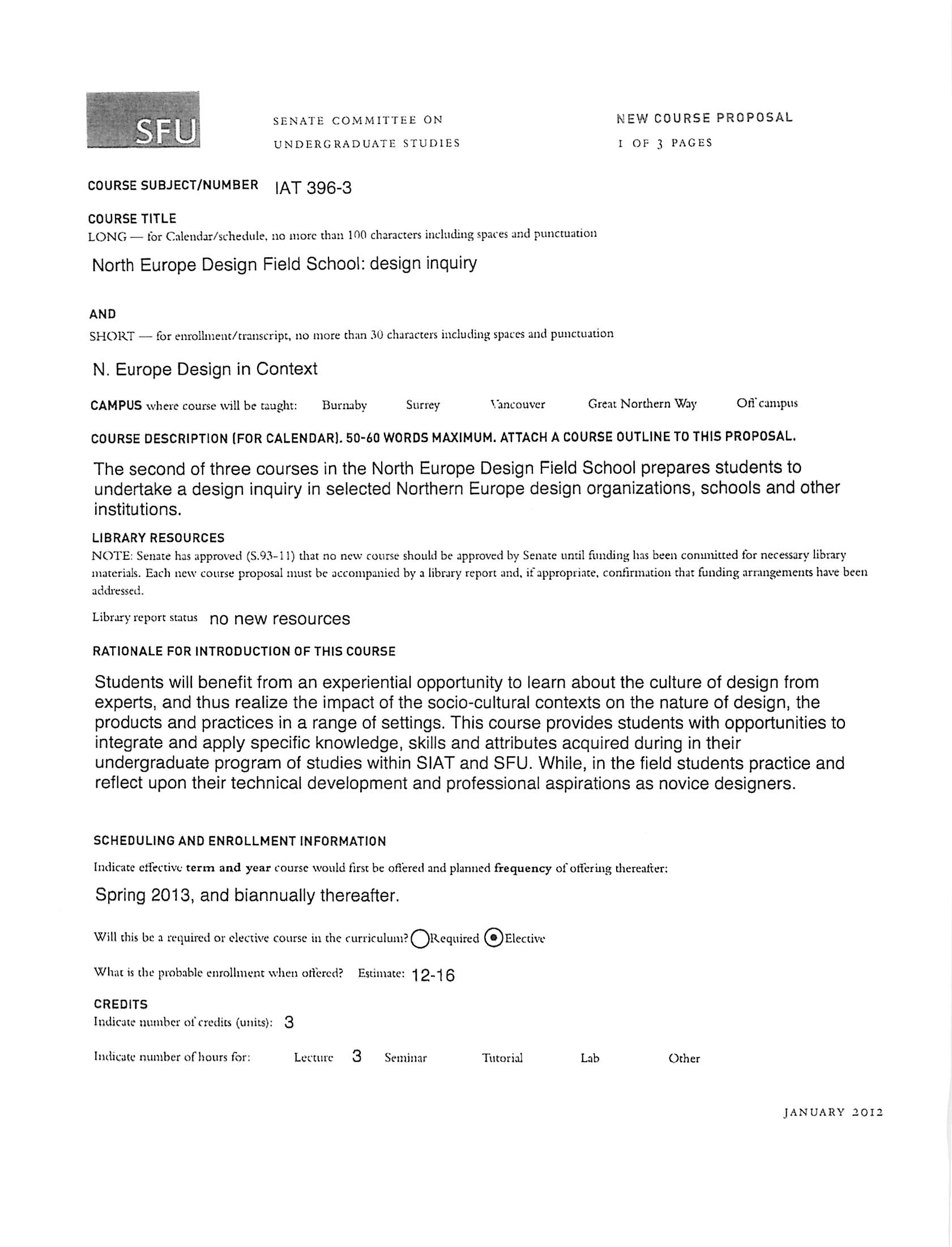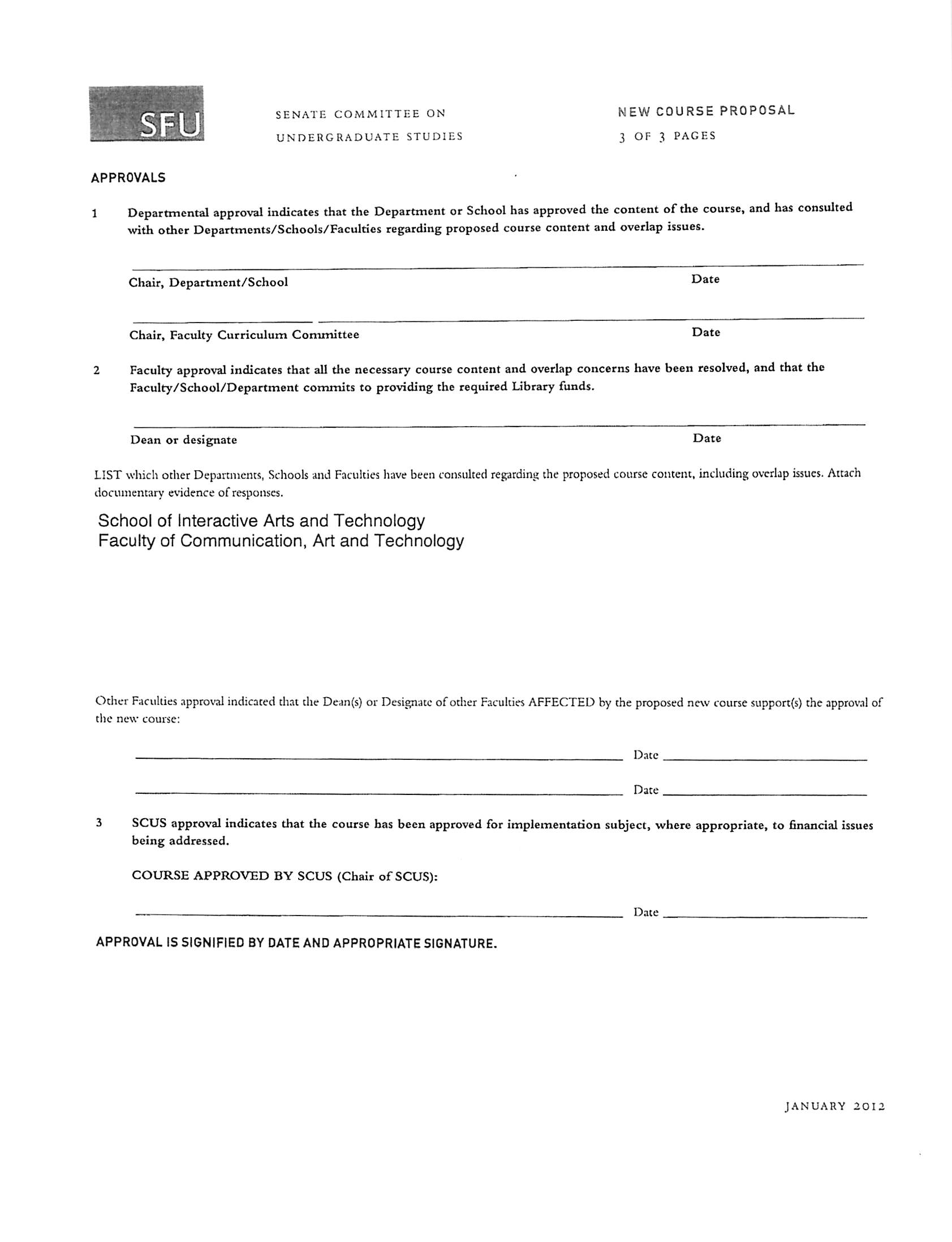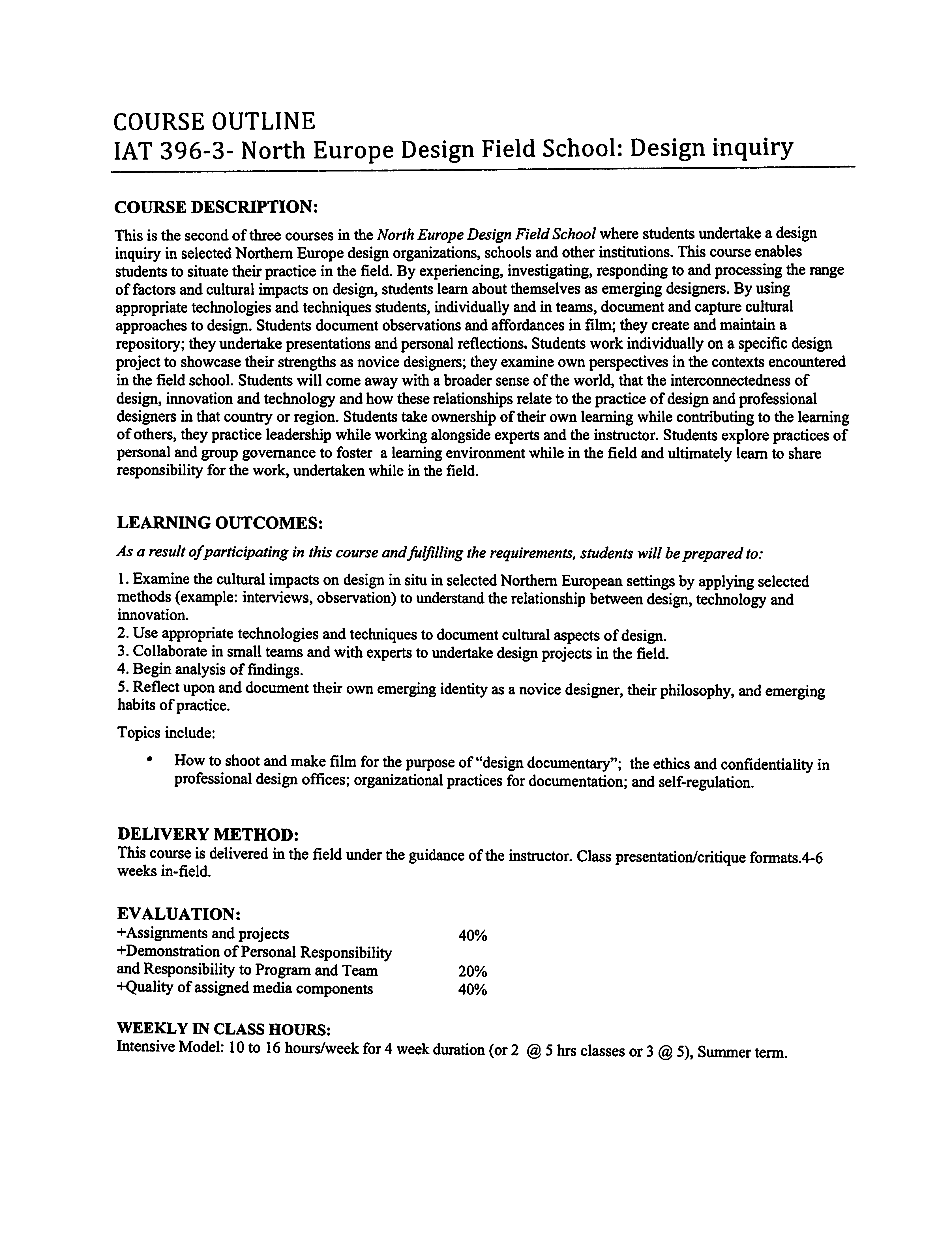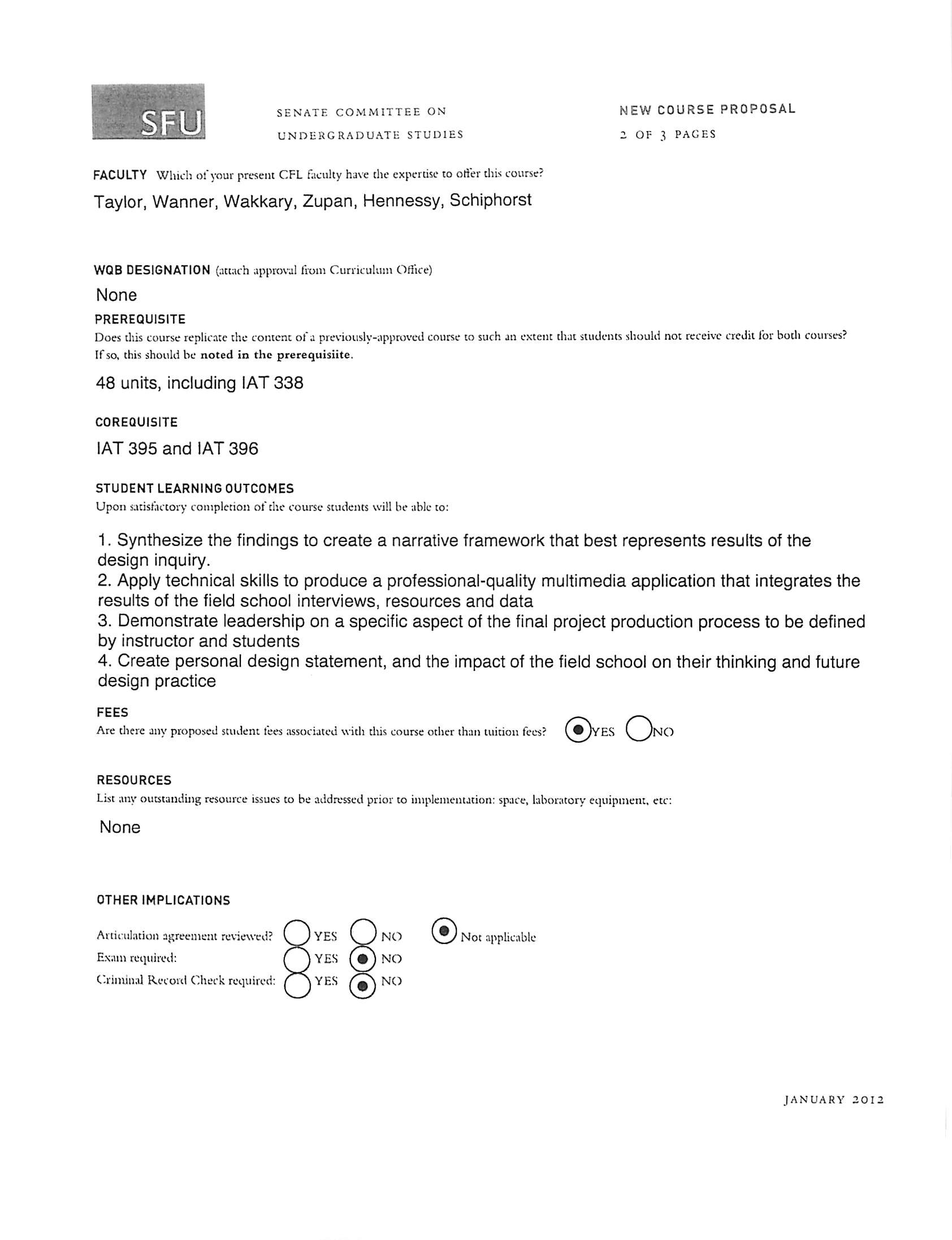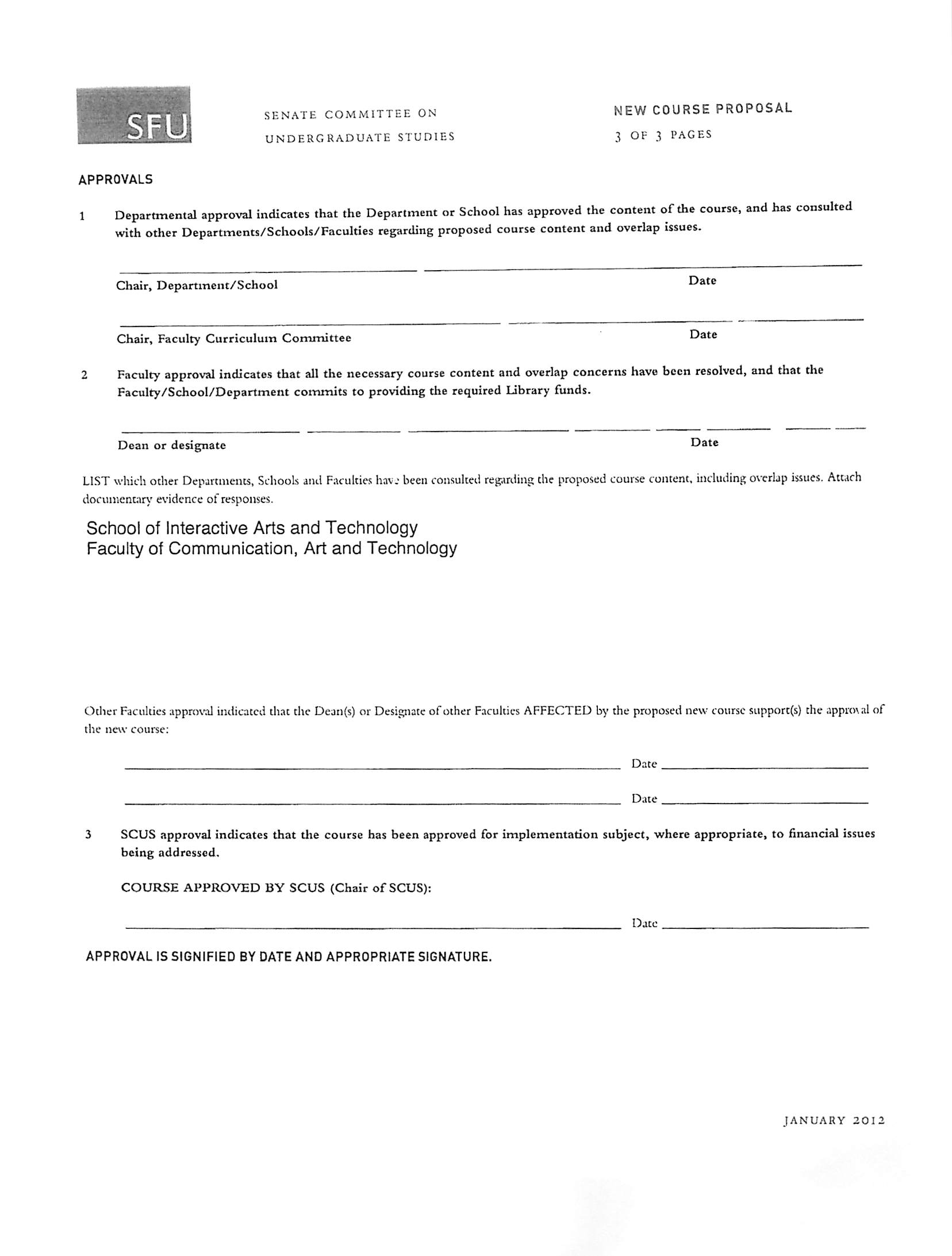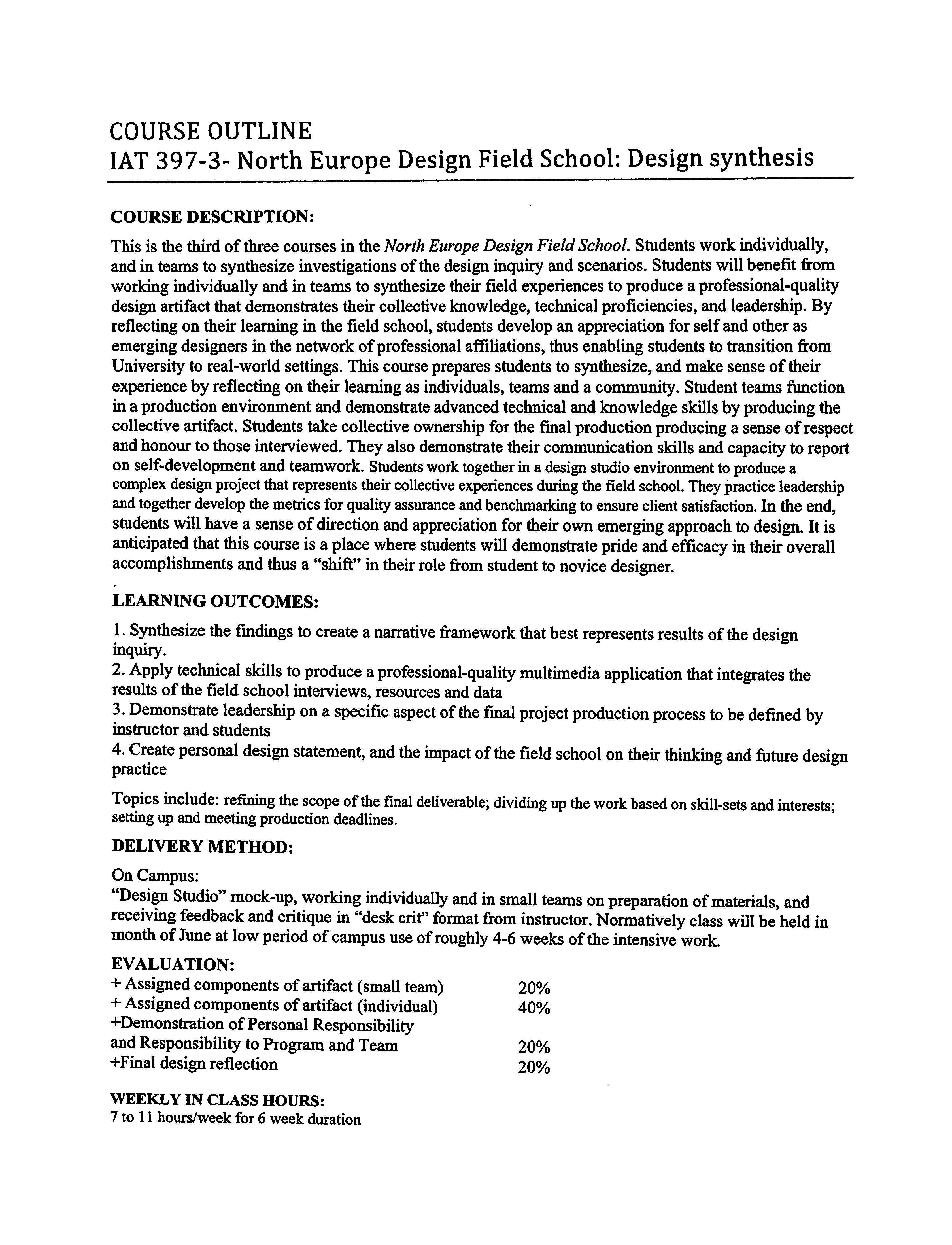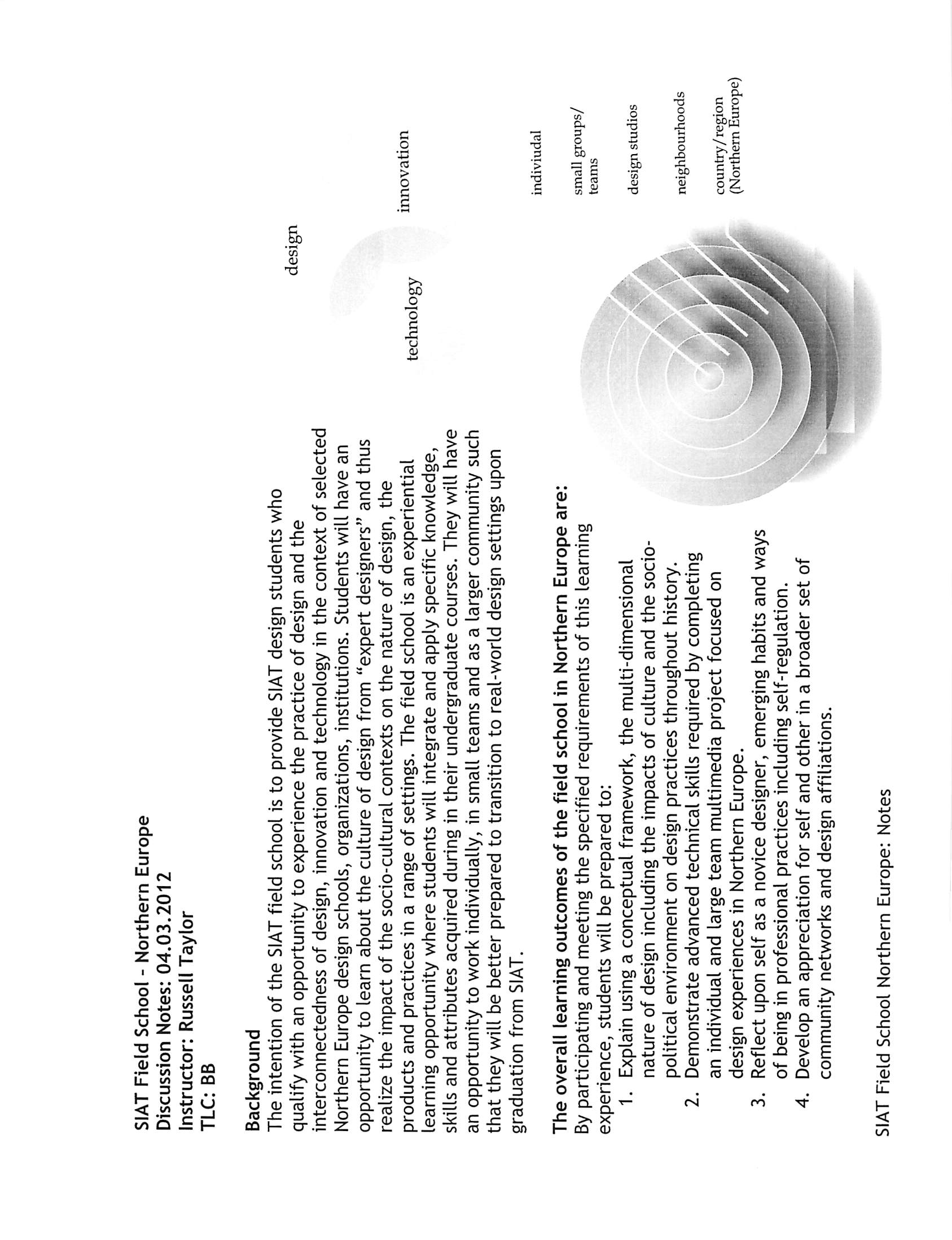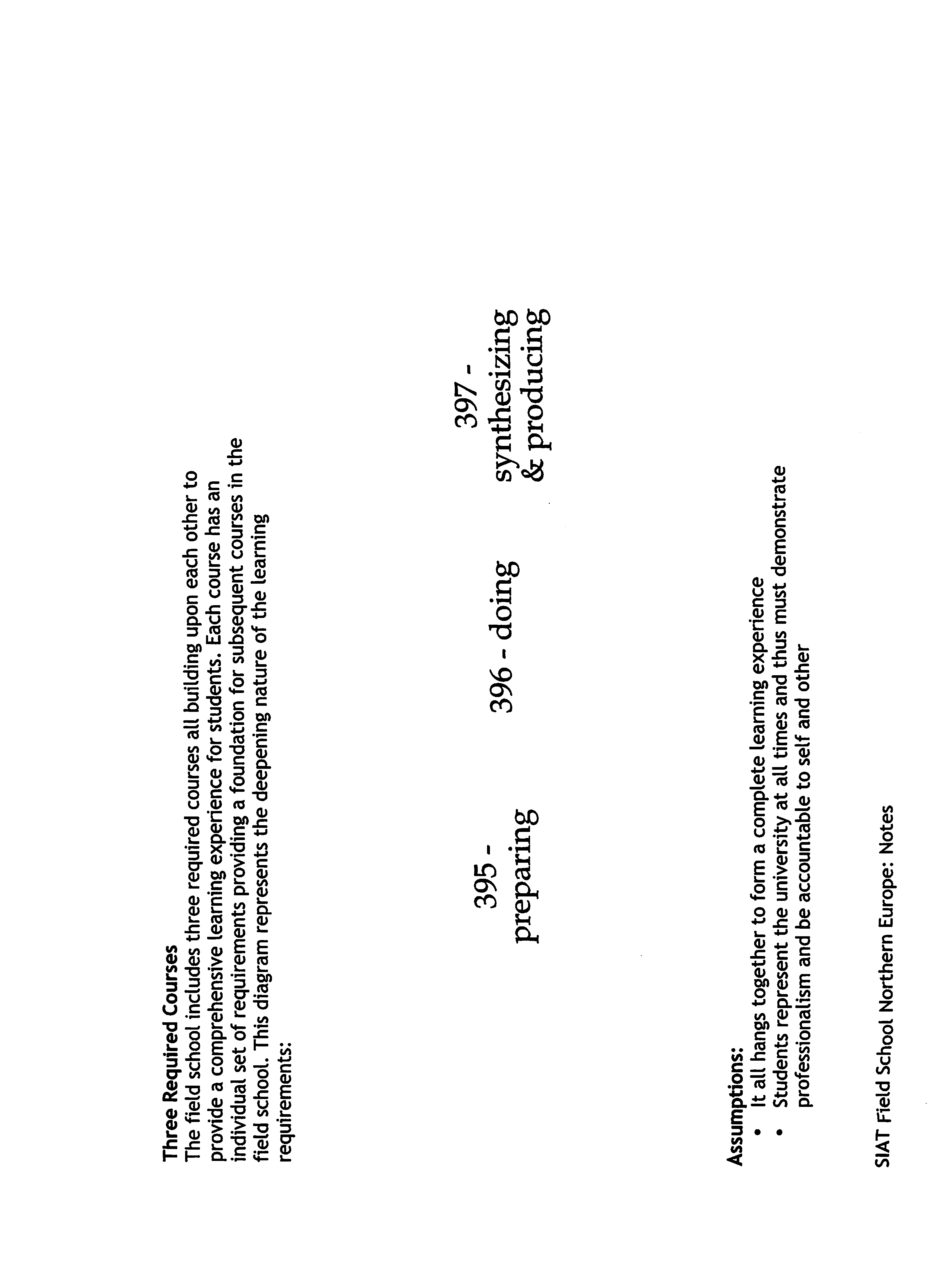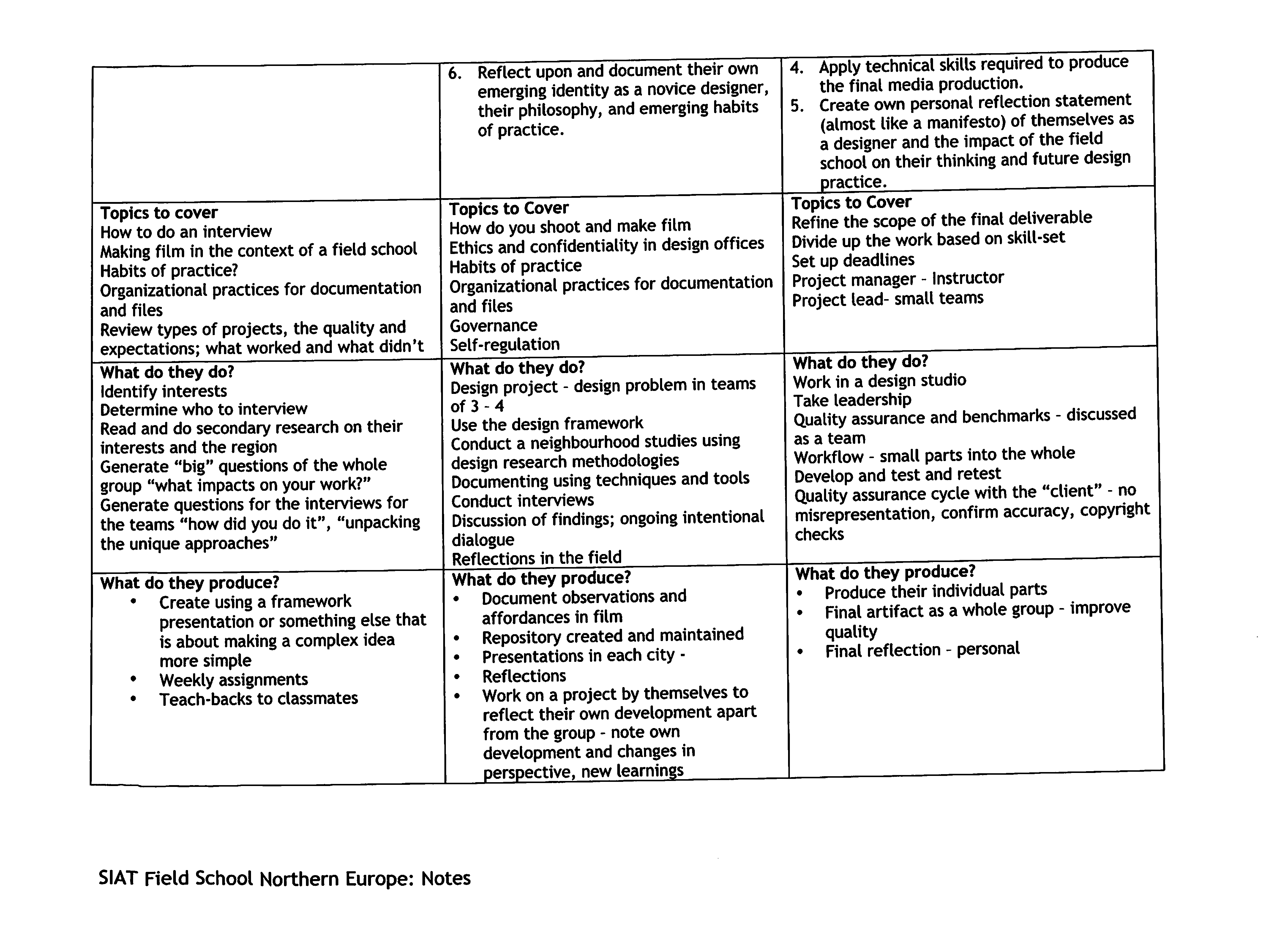SFU
MEMORANDUM
ATTENTION
FROM
RE:
S.12-111
OFFICE OF THE ASSOCIATE VICE-PRESIDENT, ACADEMIC AND
ASSOCIATE PROVOST
University Drive,
Burnaby, BC
Canada V5A1S6
TEL: 778.782.4636
FAX: 778.782.5876
Senate
Bill Krane, Chair
Senate Committee on
Undergraduate Studies
,r
^
Faculty of Communication, Art and Technology (SCUS 12-33)
DATE
PAGES
www.sfu.ca/vpacademic
June 8, 2012
1/1
For information:
Acting under delegated authority at its meeting of June 7, 2012, SCUS approved the following
curriculum revisions:
LTechOnelSCUS 12-33b)
(i) Deletion of reference to the TECHOne as a stand-alone program effective Fall 2012.
2. School for the Contemporary Arts ISCUS 12-33c)
(i) Prerequisite changes to FPA 262, 263, 264, 265, 268, 269, 362, 363, 364, 365, 368, 369
(ii) BFA Program Continuance effective Fall 2013
3. School of Interactive Arts and Technology (SCUs 12-33d)
(i) New Course Proposals effective Spring 2013:
IAT 395-3, North Europe Design Field School: Contexts of Design
IAT 396-3, North Europe Design Field School: Design Inquiry
IAT 397-3, North Europe Design Field School: Design Synthesis
Senators wishing to consult a more detailed report of curriculum revisions may do so by going
to Docushare: https://docushare.sfu.ca/dsweb/View/Collection-12682
If you are unable to access the information, please call 778-782-3168 or email
shelley qairfdsfu.ca.
SIMON PRASES UNIVERSITY
ENGAGING THE WORLD
SFU
FACULTY OF COMMUNICATION, ART AND TECHNOLOGY
Office of the Dean
Harbour Centre 7410
515 West Hastings Street
Vancouver, BC, V6B 5K3
MEMORANDUM
ATTENTION
FROM
RE:
Jo Hinchliffe
Associate Registrar
DD Kugler, Chair
Undergraduate Curriculum Committee
Faculty of Communication, Art,and Technology
TechOne
TEL 778.782.8790
FAX 778.782.8789
DATE
May 28, 2012
PAGES
1
www.fcat.sfu.ca
InJanuary 2011, SCUS approved SIAT's proposed roll-over of TechOne into first-year IAT
courses. As a result, TechOne is no longer a stand-alone program, and no student can be
admitted directly into TechOne. All references to TechOne as a stand-alone program should be
removed.
TechOne will be removed from the FCAT webpage.
A proposal to delete the four remaining TechOne courses
TECH101
TECH101W
TECH114
TECH124
will be presented at the next FCAT-UCC meeting.
I hope this clarifies the TechOne situation.
DD Kugler
S I M O N RASER UNIVERSITY
I HIN K IN G OF THE WORLD
SFU
FACULTY OF COMMUNICATION, ART AND TECHNOLOGY
Office of the Dean
SCUS12-33c
Harbour Centre 7410
515 West Hastings Street
Vancouver, BC, V6B 5K3
TEL 778.782.8790
www.fcat.sfu.ca
MEMORANDUM
ATTENTION
Bill Krane, Chair
Senate Committee on Undergraduate Studies
DD Kugler, Chair
Undergraduate Curriculum Committee
Faculty of Communication, Art,andTechnology
SCUS,June7,2012
DATE
May 25, 2012
FROM
PAGES
30, including cover memo
RE:
On May 22, 2012, the Faculty of Communication, Art and Technology Undergraduate
Curriculum Committee approved the following curricular revisions:
School for the Contemporary Arts memo
o Visual Arts prerequisite changes
o Academic Continuance Policy
o BC 12 Admission Changes
School
of Interactive Arts + Technology memo
o IAT 395/396/397: new course proposals
Please place these items on the next meeting of SCUS.
DD Kugler
SIM O N FR ASEU U N IV ERS1 T Y
I IIINMNi; 0 1 1 IIC WOKl II
SFU
SCHOOL FOR THE CONTEMPORARY ARTS
Simon FraserUniversity
TEL 778.782.3363
Email: ca@sfu.ca
8888 University Drive
Burnaby, BC V5A 1S6
MEMORANDUM
ATTENTION
DD Kugler, Chair
DATE
May 1,2012
Faculty of Communication, Art and Technology
Undergraduate Curriculum Committee
FROM
Rob Kitsos, Associate Chair
PAGES
10
School for the Contemporary Arts
•p.
Curriculum Revisions
At its meeting of 04 20 2012, the School for the Contemporary Arts
approved the attached curricular revisions: (summary of listings either in
quotations)
•
Calendar Changes to Visual Art Courses
•
SCA Academic Continuance Policy
•
BC12 Admission Changes
Would you please place this/these proposals on the agenda of the next
meeting of the Faculty of Communication, Art and Technology
Undergraduate Curriculum Committee?
Thank you,
Rob Kitsos
Associate Chair, School for the Contemporary Arts
SIMON FRASER UNIVERSITY
ihinkingof mi wmnn
Senate Committee on
Undergraduate studies
COURSE CHANGE/DELETION FORM
Existing Course Number:
Existing Title: FPA 262, FPA 263, FPA 264, FPA 265, FPA 268, FPA 269, FPA 362, FPA
363, FPA 364, FPA 365, EPA 368, FPA 369
Please check appropriate revision(s):
Course Number:
Credit Hours:
Description:
Course deletion:
Prerequisite:
X
Title:
Vector:
(Lect/Sem/Tut/Lab)
SCUS12-33c(i)
FROM:
TO:
FPA 262-3 Methods and Concepts:
Drawing-based Practices
A studio course introducing drawing
practices as they relate to practical,
conceptual, aesthetic and historical
issues in contemporary art. Prerequisite:
FPA 160. A course materials fee is
required. Students will receive credit for
either FPA 262 or 362, but not both.
FPA 263-3 Methods and Concepts:
Painting-based Practices
A studio course introducing painting
practices as they relate to practical,
conceptual, aesthetic and historical
issues in contemporary art. Prerequisite:
FPA 161 and status as an approved major
or extended minor in visual art. A course
materials fee is required. Students will
receive credit for either FPA 263 or 363,
but not both.
FPA 262-3 Methods and Concepts:
Drawing-based Practices
A studio course introducing drawing
practices as they relate to practical,
conceptual, aesthetic and historical
issues in contemporary art. Prerequisite:
FPA 160 or permission from Visual Art
Area. A course materials fee is required.
FPA 263-3 Methods and Concepts:
Painting-based Practices
A studio course introducing painting
practices as they relate to practical,
conceptual, aesthetic and historical
issues in contemporary art. Prerequisite:
FPA 160 or permission from Visual Art
Area. A course materials fee is required.
FPA 264-3 Methods and Concepts:
Sculptural Practices
A studio course introducing sculptural
practices as they relate to practical,
conceptual, aesthetic and historical
issues in contemporary art. Prerequisite:
FPA 161 or 170. FPA 264 is identical to
FPA 364 and students may not take both
courses for credit. A course materials fee
is required.
FPA 265-3 Methods and Concepts: Photo-
based Practices
A studio course introducing
photographic practices as they relate to
practical, conceptual, aesthetic and
historical issues in contemporary art.
Prerequisite: FPA 161 and status as an
approved major or extended minor in
visual art. A course materials fee is
required. Students will receive credit for
either FPA 265 or 365, but not both.
FPA 268-3 Methods and Concepts:
Spatial Presentation
A studio course introducing spatial
presentation practices as they relate to
practical, conceptual, aesthetic and
historical issues in contemporary art.
Prerequisite: FPA 161 or 170. A course
materials fee is required. Students can
only receive credit for one of FPA 163,
268 or 368.
FPA 269-3 Methods and Concepts:
Selected Topics
A studio course introducing topics in art-
making practices as they relate to
practical, conceptual, aesthetic and
historical issues in contemporary art.
This course may be taken more than
once for credit under a different topic.
Prerequisite: FPA 161 and status as an
approved major or extended minor in
visual art. A course materials fee is
required.
FPA 264-3 Methods and Concepts:
Sculptural Practices
A studio course introducing sculptural
practices as they relate to practical,
conceptual, aesthetic and historical
issues in contemporary art. Prerequisite:
FPA 160 orVisual Art Area permission. A
course materials fee is required.
FPA 265-3 Methods and Concepts: Photo-
based Practices
A studio course introducing
photographic practices as they relate to
practical, conceptual, aesthetic and
historical issues in contemporary art.
Prerequisite: FPA 161 and status as an
approved major or extended minor in
visual art or Visual Art Area Permission.
A course materials fee is required.
FPA 268-3 Methods and Concepts:
Spatial Presentation
A studio course introducing spatial
presentation practices as they relate to
practical, conceptual, aesthetic and
historical issues in contemporary art.
Prerequisite: FPA 160 or Visual Art Area
permission. A course materials fee is
required.
FPA 269-3 Methods and Concepts:
Selected Topics
A studio course introducing topics in art-
making practices as they relate to
practical, conceptual, aesthetic and
historical issues in contemporary art.
This course may be taken more than
once for credit under a different topic.
Prerequisite: FPA 160 or Visual Art Area
permission. A course materials fee is
required.
FPA 362-3 Methods and Concepts:
Drawing-based Practices
Presents drawing practices as they relate
to practical, conceptual, aesthetic and
historical issues in contemporary art.
Additional assignments will be required
for students taking the course at this
level. Prerequisite: FPA 161 and status as
an approved major or extended minor in
visual art. A course materials fee is
required. Students will receive credit for
either FPA 262 or 362, but not both.
FPA 363-3 Methods and Concepts:
Painting Practices
Presents painting practices as they relate
to practical, conceptual, aesthetic and
historical issues in contemporary art.
Additional assignments will be required
for students taking the course at this
level, (studio) Prerequisite: FPA 161 and
status as an approved major or extended
minor in visual art. A course materials
fee is required. Students will receive
credit for either FPA 263 or 363, but not
both.
FPA 364-3 Methods and Concepts:
Sculptural Practices
Presents sculptural practices as they
relate to practical, conceptual, aesthetic
and historical issues in contemporary art.
Additional assignments will be required
for students taking the course at this
level. Prerequisite: FPA 161 and status as
an approved major or extended minor in
visual art. A course materials fee is
required. Students will receive credit for
one of FPA 264, 170, or 364.
FPA 362-3 Methods and Concepts:
Drawing-based Practices
Presents drawing practices as they relate
to practical, conceptual, aesthetic and
historical issues in contemporary art.
Additional assignments will be required
for students taking the course at this
level. Prerequisite: FPA 160 or Visual Art
Area permission. A course materials fee
is required.
FPA 363-3 Methods and Concepts:
Painting Practices
Presents painting practices as they relate
to practical, conceptual, aesthetic and
historical issues in contemporary art.
Additional assignments will be required
for students taking the course at this
level, (studio) Prerequisite: FPA 160 or
Visual Art Area Permission. A course
materials fee is required.
FPA 364-3 Methods and Concepts:
Sculptural Practices
Presents sculptural practices as they
relate to practical, conceptual, aesthetic
and historical issues in contemporary art.
Additional assignments will be required
for students taking the course at this
level. Prerequisite: FPA 160 or Visual Art
Area permission. A course materials fee
is required.
FPA 365-3 Methods and Concepts: Photo-
based Practices
FPA 365-3 Methods and Concepts: Photo-
based Practices
Presents photo-based practices as they
relate to practical, conceptual, aesthetic
and historical issues in contemporary art.
Additional assignments will be required
for students taking the course at this
level. Prerequisite: FPA 161 and status as
an approved major or extended minor in
visual art. A course materials fee is
required. Students will receive credit for
either FPA 265 or 365, but not both.
FPA 368-3 Methods and Concepts:
Spatial Presentation
A studio course introducing spatial
presentation practices as they relate to
practical, conceptual, aesthetic and
historical issues in contemporary art.
Prerequisite: FPA 161 or 170. Students
can receive credit for only one of FPA
163, 268 or 368. A course materials fee is
required.
FPA 369-3 Methods and Concepts:
Selected Topics
A studio course presenting topics in art-
making practices as they relate to
practical, conceptual, aesthetic and
historical issues in contemporary art.
This course may be taken more than
once for credit under a different topic.
Prerequisite: FPA 161 and status as an
approved major or extended minor in
visual art. A course materials fee is
required.
Presents photo-based practices as they
relate to practical, conceptual, aesthetic
and historical issues in contemporary art.
Additional assignments will be required
for students taking the course at this
level. Prerequisite: FPA 160 or Visual Art
Area permission. A course materials fee
is required.
FPA 368-3 Methods and Concepts:
Spatial Presentation
A studio course introducing spatial
presentation practices as they relate to
practical, conceptual, aesthetic and
historical issues in contemporary art.
Prerequisite: FPA 160 or Visual Art Area
Permission. A course materials fee is
required.
FPA 369-3 Methods and Concepts:
Selected Topics
A studio course presenting topics in art-
making practices as they relate to
practical, conceptual, aesthetic and
historical issues in contemporary art.
This course may be taken more than
once for credit under a different topic.
Prerequisite: Prerequisite: FPA 160 or
Visual Art Area Permission. A course
materials fee is required.
Ifthis course replicates the content of a previously approved course to the extent that students
should not receive credit for both courses, this should be noted in the prerequisite.
Effective term and year:
Tanuarv. 2013
School for the Contemporary Arts
Visual Art Area
Prerequisites changes.
Spring 2012
Rationale:
In the SCA Visual Art Methods and Concepts courses, the lower level students
are in the same class as upper level students so that, for example, FPA 262 will
be the same class as FPA 362. These classes are intended to give students an
introduction to specialized material knowledge to bring back into the core courses
in the Major and Minor programs. Traditionally a student has not been allowed to
repeat these courses, even at a different (upper level) course number.
Changing the prerequisites across all of the methods and concepts courses so
that entry is either after completion of FPA 160 or by permission can allow a) all
interested students access to the class with permission, who have not taken FPA
160, and b) a student wishing to extend their exploration of the medium further to
take the class a second time under the other course number.
These proposed changes in prerequisites will be the same for each methods and
concepts course thus streamlining access to the courses.
SCUS12-33clii)
Contemporary Arts - BFA Academic Continuance Policy
Declaration and continuation
of Major in the School for the Contemporary Arts
New Policy:
All BFA students who successfullycomplete the acceptanceprocess within the School for the
Contemporary Arts are offered the status of 'Major'in a specific area of study enteringthe first
year. In order to remain a major, all students are required to maintain a GPA (FPA) of 3.0.
Rationale:
The School for the Contemporary Arts is reviewing curricular changes that facilitate greater
recruitment strategies, flexibility, and simplicity across all areas. While the SCA has maintained
some growth during the transition into the Woodward building, it is important for us to continue
to focus on increasing and retaining students. One of the challenges has been the consistency of
when our students declare their majors in all our areas and how we track academic continuance.
This new policy will make it easier for our national and international recruitment staff to
articulate the process of admissions and provide a competitive offer for potential students. At
present, approximately 10% of our BFA students fall below the 3.0 average. The 3.0 FPA
average requirement will help sustain a high academic standard in the SCA.
Process:
After a student has declared a major in Contemporary Arts, he or she will need to maintain their
BFA ProgramGPA (FPA) at a minimum of 3.0. Maintenance of the BFA Program GPAlevel
willbe evaluated at the end of the 1stand2ndacademic years, normally at theend of the Spring
Semester. A student who falls below a BFA Program GPA of 3.0 willlosetheir status as major,
and meet with the SC Advisor.
•
If the studenthasfinished first year,they will normally have one year to increase the BFA
Program GPA to 3.0 or above in order to re-establish the major.
•
If the student has finished second year, they will need to meet with the Area Coordinator and
the Advisor to determine 1)if the BFA Program GPA canbe raisedandthe major canbe re
established and 2)plan their academic career for either re-establishing the major, or pursuing
a SCA Extended Minor, or the FCAT BA Double Minor.
Senate Committee on
Undergraduate studies
CALENDAR
CHANGE
FORM
Entrance Requirements for SCA programs
Rationale:
This new policy will make our the application process easier to administer within the SCA and help sustain a
high academic standard in the SCA.
p
a^/
a
/b^
Remove from Calendar:
(Dance Major/ Extended Minor Program)
Continuation in the dance major is contingent upon the
successful completion
of FPA122,123.124 and 129 and the
approval
of the Dance Area. Interviews will be held at the
end
of the first year and approval will be based on the
student's potential, progress, academic record and suitability
for the program.
(Film
Major Program)
Film students who wish to complete the film major may
apply for admission to the BFA major program after
completing FPA 231, normally at the end of the second year
of study. Approval will be based on the students creative
work and academic record in required lower division
courses.
(Music
Major Program)
Entry to specific courses required for the music major is by
interview, usually scheduled for early spring and late
summer. Contact the general office to make an appointment.
(Theatre Major Program)
Students who wish to enrol in the theatre performance major
normally complete FPA 150,151, and 170, and are advised
to complete other courses required for the major prior to
auditioning for entry to the program
(Visual Art Major Program)
Entry to the visual art major (BFA) program is granted after
completion of FPA 111,160,161, and 168 in the first year
Followed by an application to FPA 260. Following the
completion of FPA 260,261 and 210 entry into visual art
Add to
ityMtttefr
{^Requirements:
BFA Academic Continuance Policy
After a student has declared a major in
Contemporary Arts, he or she will need to
maintain their BFA Program GPA (FPA) at a
minimum of 3.0. Maintenance of the BFA
Program GPA level will be evaluated at the end
of the 1st and 2nd academic years, normally at
the end of the Spring Semester. A student who
falls below a
BFA Program GPA of 3.0 will lose
their status as major, and meet with the SC
Advisor. If the student has finished first year,
they will normally have one year to increase the
BFA Program GPA to 3.0 or above in order to
re-establish the major. If the student has finished
second year, they will need to meet with the
Area Coordinator and the Advisor to determine
1) if the BFA Program GPA can be raised and
the major can be re-established and 2) plan their
academic career for either re-establishing the
major, or pursuing a SCA Extended Minor, and
the FCAT BA Double Minor.
major is granted based on an application. Both applications
are determined by grades
and portfolio assessments, usually
scheduled at the end of the spring term. Contact the general
office for further information.
(Visual Art Extended Minor Program)
Entry to the Visual Art Extended Minor program, after
completion of FPA 111,160,161, and 168 in the first year,
is determined by grades and portfolio assessments, usually
scheduled at the end of the spring term. Contact the general
office for further information.
Effective term and year:
Fall. 2013
SFU
MEMORANDUM
FACULTY OF COMMUNICATION, ART AND TECHNOLOGY
School of Interactive Arts + Technology
Simon Fraser University Surrey
TEL778.782.7555
250 - 13450 102~» Avenue, Surrey, BC
FAX778.782.7478
Canada V3T0A3
www.siat.sfu.ca
ATTENTION
Don Kugler, Associate Dean, FCAT
FROM
John Dill
RE:
SIAT Curriculum Changes
DATE
Wednesday, May16,2012
SCUS12-33d
Please includethe attached new courseproposals for discussion and vote at the next FCAT UCC meeting.
The
proposal is for a new Field School, as I'd noted at aprevious FCAT UCC meeting. This is for a
Northern Europeandesign field school, and consists of proposals for a package of 3 related courses.
Included arethe new course proposals, course outlinesand two background documents to give a 'big-
picture' description. All are from the course proposer, Russell Taylor.
Sincerely,
John Dill
Chair, Undergraduate Curriculum Committee
School of Interactive Arts + Technology
Faculty of Communication, Art and Technology
Simon FraserUniversity
778-782-7555 John dill@.sfu.ca
SIMON FRASER UNIVERSITY
thinking of the world
SFU
SENATE COMMITTEE ON
NEW COURSE PROPOSAL
UNDERGRADUATE STUDIES
I OF 3 PAGES
COURSE SUBJECT/NUMBER
\£J
395-3
COURSE TITLE
LONG — for Calendar/schedule, no more than 100 characters including spaces and punctuation
North Europe Design Field School: contexts of design
AND
SHORT—
for enrollment/transcript, no morethan 30characters including spaces andpunctuation
N. Europe Design Histories
CAMPUS
where course will betaught:
Buniaby
Surrey
Vancouver
Greac Northern Way
Offcampus
COURSE DESCRIPTION (FOR CALENDAR). 50-60 WORDS MAXIMUM. ATTACH A COURSE OUTLINE TO THIS PROPOSAL.
The first of three courses in the North Europe Design Field School prepares qualified students to
explore the contexts and interconnectedness of design, innovation and technology in selected
Northern Europe design organizations, schools and other institutions.
LIBRARY RESOURCES
NOTE: Senate has approved (S.93-11) that no new course should be approved by Senate until funding has been committed for necessary library
materials. Each new course proposal must be accompanied by alibrary report and, ifappropriate, confirmation that funding arrangements have been
addressed.
Library report status nO new reSOUTCeS
RATIONALE FOR INTRODUCTION OF THIS COURSE
This Northern Europe Field School was successfully pilot-tested in Summer2011 and confirmed
the benefit for senior level SIAT students to engage with different contexts in the study of design.
As a destination of study, this field school exposes students to the most economically-successful
nations of the EU, where design is a major factor in the economy. As ambassadors of SFU,
students must be prepared for the opportunities to share their expertise, to learn from others, and
engage professionally while studying abroad. Establishing a base for this inquiry begins with
students exploring the history, culture and socio-political factors influencing design.
SCHEDULING AND ENROLLMENT INFORMATION
Indicate effective term and year course would first be offered and planned frequency of offering thereafter:
Spring/Summer 2013, and biannually thereafter.
Will this be a required or elective course inthe curriculum? f"}Required (•)Elective
What is the probable enrollment when offered?
Estimate: "|2-1 6
CREDITS
Indicate number of credits (units):
3
Indicate numbet. of hours for:
Lecture
3
Seminar
Tutorial
Lab
Other
JANUARY 2012
SFU
SENATE COMMITTEE ON
UNDERGRADUATE STUDIES
NEW COURSE PROPOSAL
2 OP 3 PAGES
FACULTY Which ofyour present CFL faculty ha\e the expertise to offer this course?
Taylor, Wanner, Wakkary, Zupan, Hennessy, Schiphorst
WQB DESIGNATION (attach approval from Curriculum Office)
None
PREREQUISITE
Does this course replicate the content of apreviously-approved course to such an extent diat students should not receive credit for both courses?
If so. this should be noted in the prerequisiite.
48 units, including IAT 338
COREQUISITE
IAT 396 and IAT 397
STUDENT LEARNING OUTCOMES
Upon satisfactory completion of the course students will be able to:
1. Define their design interests in consultation with the instructor and others in the course
2. Explore the history, culture and socio-political factors influencing design in
Northern Europe as distinct from the North American context.
3. Consult with peers and instructor to determine the selection of design contexts and designers
that will form the basis of the learning in course 2.
4. Collaborate to develop a plan for examining Design in Northern Europe in the selected region
and settings of study
5. Create a personal study and travel plan for the field school
FEES
Are dierc any proposed student fees associated with this course other than tuition
fees?
(V)yES (Jn°
RESOURCES
Listany outstandingresource issues to be addressed prior to implementation: space, laboratoryequipment, etc:
None
OTHER IMPLICATIONS
Articulation agreement reviewed?
Exam required:
Criminal Record Check required:
b Qno ®
NO
NO
Not applicable
JANUARY 2012
SFU
APPROVALS
SENATE COMMITTEE ON
NEW COURSE PROPOSAL
UNDERGRADUATE STUDIES
3 OF 3 PAGES
1
Departmental approval indicates that the Department or School has approved the content of the course, and has consulted
with other Departments/Schools/Faculties regarding proposed course content and overlap issues.
Chair, Department/School
Date
Chair, Faculty Curriculum Committee
Date
2
Faculty approval indicates that all the necessary course content and overlap concerns have been resolved, and that the
Faculty/School/Department commits to providing the required Library funds.
Dean or designate
Date
LIST which other Departments, Schools and Faculties have been consulted regarding the proposed course content, including overlap issues. Attach
documentary evidence of responses.
School of Interactive Arts and Technology
Faculty of Communication, Art and Technology
Other Faculties approval indicated that the Dean(s) or Designate ofother Faculties AFFECTED by the proposed new course supports) the approval of
the new course:
Date
Date
3
SCUS approval indicates diat the course has been approved for implementation subject, where appropriate, to financial issues
being addressed.
COURSE APPROVED BY SCUS (Chair of SCUS):
Date
APPROVAL IS SIGNIFIED BY DATE AND APPROPRIATE SIGNATURE.
JANUARY 2012
COURSE OUTLINE
IAT 395-3- North Europe Design Field School: Contexts of design
COURSE DESCRIPTION:
This is the first ofthree courses in the
NorthEuropeDesign Field School
and is intended to prepare students to go
into the field. Senior students are selected for the field school through a competitive process that affords entry to this
first course. Students explore the contexts and interconnectedness
ofdesign, innovation and technology in selected,
leading Northern European design organizations, schools and other institutions. This course provides a gateway for
students to explore the contexts of design by preparing students to engage in design conversation with designers and
others in nations where design is a major factor in the economy. As ambassadors
of SFU, students must be prepared
for the opportunities to share their expertise, to learn from others, and engage professionally while studying abroad.
Through facilitated discussions, students will begin to develop self-awareness oftheir interests, and questions about
design and examine the history, social, cultural, political and economic factors and relationships that influence
designers, artisans, craftspeople and others involved in design in Northern Europe . Students, with the guidance of
the instructor, will determine through discussion and inquiry, the network of designers, design schools,
manufacturers, as well as public and other private institutions that form the itinerary and inquiry of a given term of
study. Students will prepare a travel and personal development plan as well as contribute to the overall plan for the
field school.
LEARNING OUTCOMES:
Upon completion ofthe course andfulfillmentofexpectations, students will bepreparedto:
1. Define their design interests in consultation with the instructor and others in the course
2. Explore the history, culture and socio-political factors influencingdesign in Northern Europe as distinct from the
North American context.
3. Consult with peers and instructor to determine the selection of design contexts and designers that will form the
basis of the learning in course 2.
4. Collaborate to develop a plan for examining Design in Northern Europe in the selected region and settings of
study
5. Create a personal study and travel plan for the field school
TOPICS:
•
the history and contexts of design in northern Europe
•
design-based inquiry
•
planning and conducting interviews
•
documentation and film-making in the context of a field school
•
habits ofpractice,
•
organizational practices for documentation and the quality and expectations.
DELIVERY METHOD:
Thecourse applies a seminar format andfeatures an intensive preparatory learning phaseof 2-4weeks priorto
departure where students engage in on campus activities including presentations andpeerteaching underthe
supervision and direction of faculty.
EVALUATION:
+Weekly Assignments (teams of 1, 2, 3)
60%
+Content Quizzes
20%
-rContribution to Group Tools
(for example Design Inquiry Framework)
20%
WEEKLY IN CLASS HOURS:
Intensive Model: 10to 16hours/week for4 weekduration (or2 @ 5 hrs classes or 3 @ 5), Summer term.
SENATE COMMITTEE ON
NEW COURSE PROPOSAL
UNDERGRADUATE STUDIES
I OF 3 PAGES
COURSE SUBJECT/NUMBER
\frj
396-3
COURSE TITLE
LONG — for Calendar/schedule, no more than ino characters including spaces and punctuation
North Europe Design Field School: design inquiry
AND
SHORT — for enrollment/transcript, no more than 30 characters including spaces and punctuation
N. Europe Design in Context
CAMPUS where course will be taught:
Burnaby
Surrey
Vancouver
Great Nordiern Way
Offcampus
COURSE DESCRIPTION (FOR CALENDAR). 50-60 WORDS MAXIMUM. ATTACH A COURSE OUTLINE TO THIS PROPOSAL.
The second of three courses in the North Europe Design Field School prepares students to
undertake a design inquiry in selected Northern Europe design organizations, schools and other
institutions.
LIBRARY RESOURCES
NOTE: Senate hasapproved (S.93-11) that no new courseshouldbe approved by Senate until funding has been committed for necessary library
materials. Each new course proposal must be accompanied by a library report and, if appropriate, confirmation that funding arrangementshave been
addressed.
Libraryreport status no new resources
RATIONALE FOR INTRODUCTION OF THIS COURSE
Students will benefit from an experiential opportunity to learn about the culture of design from
experts, and thus realize the impact of the socio-cultural contexts on the nature of design, the
products and practices in a range of settings. This course provides students with opportunities to
integrate and apply specific knowledge, skills and attributes acquired during in their
undergraduate program of studies within SIAT and SFU. While, in the field students practice and
reflect upon their technical development and professional aspirations as novice designers.
SCHEDULING AND ENROLLMENT INFORMATION
Indicate effectiveterm and year course would first be offered and planned frequency of offering thereafter:
Spring 2013, and biannually thereafter.
Will this be a required or elective course in the curriculum? ("jRcquired (•_)Elective
Whatis the probable enrollment whenoffered?
Estimate: "j 2-1 6
CREDITS
Indicate number of credits (units): 3
Indicate number of hours for:
Lecture
3
Seminar
Tutorial
Lab
Other
JANUARY 2012
SFU
SENATE COMMITTEE ON
UNDERGRADUATE STUDIES
FACULTY
Which ofyour present CFL faculty have the expertise to offer this course?
Taylor, Wanner, Wakkary, Zupan, Hennessy, Schiphorst
NEW COURSE PROPOSAL
2 01- 3 PAGES
WQB DESIGNATION
(attach approval from Curriculum Office)
None
PREREQUISITE
Does this course replicate the content ofa previously-approved course tosuch an extent that students should not receive credit for both courses?
If so, this should be
noted in the prerequisiite.
48 units, including IAT 338
COREQUISITE
IAT 395 and IAT 397
STUDENT LEARNING OUTCOMES
Upon satisfactory completion of the course students will be able to:
1. Examine the cultural impacts on design in situ in selected Northern European settings by
applying selected methods (example: interviews, observation) to understand the relationship
between design, technology and innovation.
2. Use appropriate technologies and techniques to document cultural aspects of design
3. Collaborate in small
teams and with experts to undertake design projects in the field.
4. Begin analysis of findings.
5. Reflect upon and document their own emerging identity as a novice designer, their philosophy,
and emerging habits of practice.
FEES
Are there any proposed student fees associated with this course other than tuition fees?
(•JYES 1,/NO
RESOURCES
List any outstanding resource issues to be addressed prior to implementation: space, laboratory equipment, etc:
None
OTHER IMPLICATIONS
Articulation agreement reviewed?
Exam required:
Criminal Record Check required:
YES
NO
YES
(•>
NO
YES
(V
NO
®
Not applicable
IANUAKY 2012
SFU
SENATE COMMITTEE ON
NEW COURSE PROPOSAL
UNDERGRADUATE STUDIES
3 OF 3 PAGES
APPROVALS
1
Departmental approval indicates that the Department or School has approved the content ofthe course, and has consulted
with other Departments/Schools/Faculties regarding proposed course content and overlap issues.
Chair, Department/School
°ate
Chair, Faculty Curriculum Committee
Date
2
Faculty approval indicates that all the necessary course content and overlap concerns have been resolved, and that the
Faculty/School/Department commits to providing the required Library funds.
Dean or designate
Date
LISTwhichother Departments, Schools and Faculties have beenconsulted regarding the proposed course content, including overlap issues. Attach
documentary evidence of responses.
School of Interactive Arts and Technology
Faculty of Communication, Art and Technology
Other Faculties approval indicated that the De.in(s) or Designate of other Faculties AFFECTED by the proposed new course support(s) the approval of
the new course:
Date
Date
3
SCUS approval indicates that the course has been approved for implementation subject, where appropriate, to financial issues
being addressed.
COURSE APPROVED BY SCUS (Chair of SCUS):
Date
APPROVAL IS SIGNIFIED BY DATE AND APPROPRIATE SIGNATURE.
JANUARY 2012
COURSE OUTLINE
IAT 396-3- North Europe Design Field School: Design inquiry
COURSE DESCRIPTION:
Thisis the second of threecourses in the
North Europe Design FieldSchool
where students undertake a design
inquiry in selected Northern Europe design organizations, schools andotherinstitutions. Thiscourse enables
studentsto situatetheir practice in the field. By experiencing, investigating, respondingto and processing the range
of factors and culturalimpacts on design,students learnaboutthemselves as emergingdesigners. By using
appropriate technologies and techniques students, individuallyand in teams, document and capture cultural
approaches to design. Students document observations and affordances in film; they create and maintain a
repository; they undertake presentations and personalreflections. Students work individually on a specific design
project to showcase their strengths as novice designers; they examine own perspectives in the contexts encountered
in die field school. Students will come away with a broader sense ofthe world, that the interconnectedness of
design, innovation and technology and how these relationships relate to the practice of design and professional
designers in that country or region. Students take ownership oftheir own learning while contributing to the learning
ofothers, they practice leadership while working alongside experts and the instructor. Students explore practices of
personal and group governance to foster a learningenvironmentwhile in the field and ultimately learn to share
responsibility for the work, undertaken while in the field.
LEARNING OUTCOMES:
Asa result ofparticipating in this course andfulfilling the requirements, students willbeprepared to:
1.Examine thecultural impacts on design in situinselected Northern European settings by applying selected
methods (example: interviews, observation) tounderstand the relationship between design, technology and
innovation.
2. Useappropriate technologies andtechniques todocument cultural aspects of design.
3. Collaborate in smallteamsand withexperts to undertake design projects in the field.
4. Begin analysis of findings.
5. Reflect upon and document their own emerging identity asa novice designer, their philosophy, and emerging
habits ofpractice.
Topics include:
•
How toshoot and make film for the purpose of"design documentary"; the ethics and confidentiality in
professional design offices; organizational practices for documentation; and self-regulation.
DELIVERY METHOD:
This course isdelivered inthe field under the guidance ofthe instructor. Class presentation/critique formats.4-6
weeks in-field.
EVALUATION:
+Assignments and projects
40%
+Demonstration of Personal Responsibility
and Responsibility to Program and Team
20%
+Qualityof assignedmedia components
40%
WEEKLY IN CLASS HOURS:
Intensive Model: 10 to 16 hours/week for 4week duration (or 2 @5hrs classes or 3@5), Summer term.
SFU
SENATE COMMITTEE ON
NEW
COURSE PROPOSAL
UNDERGRADUATE STUDIES
1 OF 3 PAGES
COURSE SUBJECT/NUMBER
|AT 397-3
COURSE TITLE
LONG — for Calendar/schedule, no more than 100 charactersincluding 'pacesand punctuation
North Europe Design Field School: design synthesis
AND
SHORT — for enrollment/transcript, no more than 3l) characters including spaces and punctuation
N. Europe Interaction Design
CAMPUS
where course will be taught:
Burnaby
Surrey
Vancouver
Great Northern Way
Offcampus
COURSE DESCRIPTION (FOR CALENDAR). 50-60 WORDS MAXIMUM. ATTACH A COURSE OUTLINE TO THIS PROPOSAL.
In the third of three courses in the North Europe Design Field School, students work individually,
and in teams to synthesize investigations and produce a professional-quality design artifact. On
completion, students are prepared to transition from University to real-world settings.
LIBRARY RESOURCES
NOTE: Senate has approved (S.93-11) that no new course should be approved bySenate until funding has beencommitted for necessary library
materials. Each newcourse proposal must be accompanied by a library report and. ifappropriate, confirmation thatfunding arrangements have been
addressed.
Library report status
RATIONALE FOR INTRODUCTION OF THIS COURSE
Students will benefit from working individually and in teams to synthesize their field experiences
to produce a professional-quality design artifact that demonstrates their collective knowledge,
technical proficiencies, and leadership. By reflecting on their learning students develop an
appreciation for self and other as emerging designers in the network of professional affiliations,
thus enabling students to transition from University to real-world settings.
SCHEDULING AND ENROLLMENT INFORMATION
Indicate effective term and yearcourse would first be
offered
and planned frequency ofoffering thereafter:
Spring 2013, and biannually thereafter.
Will this be arequired or elective course in the curriculum? Qkeuuired (•)Elective
What is the probable enrollment when offered?
F.timate: "| 2-1 6
CREDITS
Indicate number of credits (units): 3
Indicate number ofllOUtt for:
Lecture
3
Seminar
Tutorial
Lab
Other
JANUARY 2012
SFU
SENATE COMMITTEE ON
UNDERGRADUATE STUDIES
NEW COURSE PROPOSAL
2 OF 3 PAGES
FACULTY
Which of yourpresent
CFL
faculty have the expertise to otter thiscourse?
Taylor, Wanner, Wakkary, Zupan, Hennessy, Schiphorst
WQB DESIGNATION
(attach approval from Curriculum Office)
None
PREREQUISITE
Does this course replicate the content of a previously-approved course to such an extent that students should not receive credit for both courses?
If so, this should be
noted in
the
prerequisiite.
48 units, including IAT 338
COREQUISITE
IAT 395 and IAT 396
STUDENT LEARNING OUTCOMES
Upon satisfactory completion of the course students will be able to:
1. Synthesize the findings to create a narrative framework that best represents results of the
design inquiry.
2. Apply technical skills to produce a professional-quality multimedia application that integrates the
results of the field school interviews, resources and data
3. Demonstrate leadership on a specific aspect of the final project production process to be defined
by instructor and students
4. Create personal design statement, and the impact of the field school on their thinking and future
design practice
FEES
Are there any proposed student fees associated with this course other than tuition fe
:es?
(V)YES (JnO
RESOURCES
List any outstandingresource issues to be addressed prior to implementation: space, laboratoryequipment, etc:
None
OTHER IMPLICATIONS
Articulation agreement reviewed?
Exam required:
Criminal
Record Check required:
®
Not applicable
JANUARY 2012
SFU
APPROVALS
SENATE COMMITTEE ON
NEW COURSE PROPOSAL
UNDERGRADUATE STUDIES
3 OP 3 PAGES
1
Departmental approval indicates that the Department or School has approved the content of the course, and has consulted
with other Departments/Schools/Faculties regarding proposed course content and overlap issues.
Chair, Department/School
Date
Chair, Faculty Curriculum Committee
Date
2
Faculty approval indicates that all the necessary course content and overlap concerns have been resolved, and that the
Faculty/School/Department commits to providing the required Library funds.
Dean or designate
Date
LIST
which other Departments, Schools and Faculties have
been
consulted regarding the proposed
course content, including overlap issues.
Attach
documentaryevidenceof responses.
School of Interactive Arts and Technology
Faculty of Communication, Art and Technology
Other Faculties approval indicated that the Dean(s) or Designate of other Faculties AFFECTED by the proposed new course support(s) the
approval
of
the new course:
Date
Date
3
SCUS approval indicates that the course has been approved for implementation subject, where appropriate, to financial issues
being addressed.
COURSE APPROVED BY SCUS (Chair of SCUS):
__„
_ .
Date
APPROVAL IS SIGNIFIED BY DATE AND APPROPRIATE SIGNATURE.
JANUARY 2012
COURSE OUTLINE
IAT 397-3- North Europe Design Field School: Design synthesis
COURSE DESCRIPTION:
This is the third ofthree courses in the
North Europe DesignField School.
Students work individually,
and in teams to synthesize investigations of the design inquiry and scenarios. Studentswill benefit from
working individually and in teams to synthesize their field experiencesto produce a professional-quality
design artifact that demonstrates their collective knowledge, technical proficiencies, and leadership. By
reflecting on their learning in the field school, students develop an appreciation for self and other as
emerging designers in the network of professional affiliations, thus enabling students to transition from
University to real-world settings. This course prepares students to synthesize, and make sense of their
experienceby reflecting on their learning as individuals, teams and a community. Student teams function
in a production environment and demonstrate advanced technical and knowledge skillsby producing the
collective artifact. Students take collective ownership for the final production producing a sense of respect
andhonour to thoseinterviewed. Theyalsodemonstrate theircommunication skills andcapacity to report
on self-development and teamwork. Students work together ina design studio environment toproduce a
complex design project thatrepresents their collective experiences during thefield school. They practice leadership
andtogether develop themetrics forquality assurance andbenchmarking to ensure client satisfaction. In the end,
students will have a sense of direction and appreciation for their own emerging approach todesign. It is
anticipated that this course is a place where students will demonstrate pride and efficacy intheir overall
accomplishments andthus a "shift"in their role from student to novice designer.
LEARNING OUTCOMES:
1. Synthesize the findings to create a narrative framework that best represents results ofthe design
inquiry.
2. Apply technical skills to produce aprofessional-quality multimedia application that integrates the
results ofthe field school interviews, resources and data
3. Demonstrate leadership on a specific aspect ofthe final project production process to be defined by
instructor and students
4. Create personal design statement, and the impact ofthe field school on their thinking and future design
practice
Topics include: refining the scope ofthe final deliverable; dividing up the work based on skill-sets and interests;
setting up and meeting production deadlines.
DELIVERY METHOD:
On Campus:
"Design Studio" mock-up, working individually and in small teams on preparation ofmaterials, and
receiving feedback and critique in "desk crit" format from instructor. Normatively class will be held in
month of June at low period of campus use ofroughly 4-6 weeks of theintensive work.
EVALUATION:
+ Assigned components of artifact (small team)
20%
+ Assigned components of artifact (individual)
40%
+Demonstration of Personal Responsibility
and Responsibility to Program and Team
20%
+Final design reflection
20%
WEEKLY IN CLASSHOURS:
7 to 11 hours/week for 6 week duration
SIAT Field School - Northern Europe
Discussion Notes: 04.03.2012
Instructor: Russell Taylor
TLC: BB
Background
The intention of the SIAT field school is to provide SIAT design students who
qualify with an opportunity to experience the practice of design and the
interconnectedness of design, innovation and technology in the context of selected
Northern Europe design schools, organizations, institutions. Students will have an
opportunity to learn about the culture of design from "expert designers" and thus
realize the impact of the socio-cultural contexts on the nature of design, the
products and practices in a range of settings. The field school is an experiential
learning opportunity where students will integrate and apply specific knowledge,
skills and attributes acquired during in their undergraduate courses. They will have
an opportunity to work individually, in small teams and as a larger community such
that they will be better prepared to transition to real-world design settings upon
graduation from SIAT.
The overall learning outcomes of the field school in Northern Europe are:
By participating and meeting the specified requirements of this learning
experience, students will be prepared to:
1. Explain using a conceptual framework, the multi-dimensional
nature of design including the impacts of culture and the socio
political
environment on design practices throughout history.
2.
Demonstrate advanced technical skills required by completing
an individual and large team multimedia project focused on
design
experiences in Northern Europe.
3. Reflect upon
self as a novice designer, emerging habits and ways
of being in professional
practices including self-regulation.
4. Develop an appreciation for self and other in a broader set of
community networks and design affiliations.
SIAT Field School Northern Europe: Notes
design
technology
W
innovation
indiviudal
small groups/
teams
design studios
neighbourhoods
country/region
(Northern Europe)
Three Required Courses
The field school includes three required courses all building upon each other to
provide a comprehensive learning experience for students. Each course has an
individual set of requirements providing a foundation for subsequent courses in the
field school. This diagram represents the deepening nature of the learning
requirements:
397-
395
396 - doing
synthesizing
preparing
*
&producing
Assumptions:
• It all hangs together to form a complete learning experience
• Students represent the university at all times and thus must demonstrate
professionalism and be accountable to self and other
SIAT Field School Northern Europe: Notes
This table summarizes the details of each course and how they fit together:
IAT 395 - Preparing for it
This course is the first of three and is about
preparing to go to the field. Through
facilitated discussions, students will begin
to develop self-awareness of their interests,
questions about design; examine the
history, social, cultural, political and
economic factors and relationships that
influence designers and design in N. Europe;
design
continuum that includes artisans,
craft, professional designers, architects,
and business people; determine through
discussion and inquiry the network of
designers, design schools, manufacturers, as
well as public and other private institutions
that form the itinerary; getting "ready"
By the end of this course students will be
prepared to:
1. Define their design interests in
consultation with the instructor and
others in the course.
2. Explore the history of design in Northern
Europe and distinguish this from the
North American context.
3. Investigate....
4. Consult with peers and instructor to
determine the selection of design
contexts and designers that will form
the basis of the learning in course 2.
5. Create a travel plan....
396 - Doing it - reality check
This course is about being in the field
experiencing, investigating, situating their
practice, responding and processing
cultural impacts on design and reflecting
themselves as a designer (their paradigm
and themselves); using appropriate
technologies and techniques to document
and capture cultural approach to design;
developing self-awareness; learning
together with each other in small teams
with experts and with instructor; shared
responsibility for the work, the practices
while in the field and each other;
governance
By the end of this course students will be
prepared to:
1. Examine the cultural impacts on design
in situ in selected Northern European
settings.
2. Use appropriate technologies and
techniques
to document and capture
cultural approach to design;
3. Collaborate in small teams and with
experts to undertake design
explorations in
the field.
4. Undertake interviews and other
activities
5. Analyze findings
SIAT Field School Northern Europe: Notes
397 - Making Sense of it
This course is about synthesizing, and
producing a professional-level artifactand also
making sense of their experience and
reflecting on their experience as individuals,
teams and a learning community. The will be
different as a result of this experience. This
course allows students to function in a team in
a production environment and thus will
demonstrate advanced technical and
knowledge skills by producing their collective
artifact. The course assists students to take
collective ownership for final production and
also supportsstudents to have a sense of
respect and honour to those interviewed.
Students will also demonstrate their
communication skills and capacity to report on
self-development. In the end, students will
have a sense of direction and appreciation for
their own emerging approach to design. It is
anticipated that this course is a place where
students will demonstrate pride in overall
accomplishment and thus a "shift" in their role
from student to novice designer.
Bythe end of this course students will be
prepared to:
1. Synthezise the data following principles of
data analysis creating a narrative
framework that best represents the
findings.
2. Contribute to the creation of a professional
- quality multimedia application that
integrates the results of the field school
interviews, resources and data.
3. Demonstrate leadership on a specific
aspect of the final project production
process to be defined by instructor and
students
__
Topics to cover
How to do an interview
Making film in the context of a field school
Habits of practice?
Organizational practices for documentation
and files
Review types of projects, the quality and
expectations; what worked and what didn't
What do they do?
Identify interests
Determine who to interview
Read and do secondary research on their
interests and the region
Generate "big" questions of the whole
group "what impacts on your work?"
Generate questions for the interviews for
the teams "how did you do it", "unpacking
the unique approaches"
What do they produce?
•
Create using a framework
presentation or something else that
is about making a complex idea
more simple
•
Weekly assignments
• Teach-backs to classmates
6. Reflect upon and document their own
emerging identity as a novice designer,
their philosophy, and emerging habits
of practice.
Topics to Cover
How do you shoot and make film
Ethics and confidentiality in design offices
Habits of practice
Organizational practices for documentation
and files
Governance
Self-regulation
^
What do they do?
Design project - design problem in teams
of 3-4
Use the design framework
Conduct a neighbourhood studies using
design research methodologies
Documenting using techniques and tools
Conduct interviews
Discussion of findings; ongoing intentional
dialogue
Reflections in the field
What do they produce?
•
Document observations and
affordances in film
•
Repository createdand maintained
•
Presentations in each city -
•
Reflections
•
Workon a project by themselves to
reflect their own development apart
from the group - note own
development and changes in
perspective, new learnings
SIAT Field School Northern Europe: Notes
4. Apply technical skills required to produce
the final media production.
5. Create own personal reflection statement
(almost like a manifesto) ofthemselves as
a designer and the impact ofthe field
school on their thinking and future design
practice.
Topics to Cover
Refine the scopeof the final deliverable
Divide up the work based onskill-set
Set up deadlines
Project manager - Instructor
Project lead- small teams
What do they do?
Work in a design studio
Take leadership
Quality assurance and benchmarks - discussed
as a team
Workflow - small parts into the whole
Developand test and retest
Quality assurance cycle with the "client" - no
misrepresentation, confirm accuracy, copyright
checks
What do they produce?
• Produce their individual parts
•
Final artifact as a whole group - improve
quality
•
Final reflection - personal
Back to top


